2023Activity reportProject-TeamEPIONE
RNSR: 201822641L- Research center Inria Centre at Université Côte d'Azur
- Team name: E-Patient: Images, Data & MOdels for e-MediciNE
- Domain:Digital Health, Biology and Earth
- Theme:Computational Neuroscience and Medicine
Keywords
Computer Science and Digital Science
- A3.3. Data and knowledge analysis
- A3.4. Machine learning and statistics
- A4.3. Cryptography
- A4.4. Security of equipment and software
- A4.8. Privacy-enhancing technologies
- A5.2. Data visualization
- A5.3. Image processing and analysis
- A5.4. Computer vision
- A5.6. Virtual reality, augmented reality
- A5.9. Signal processing
- A6.1. Methods in mathematical modeling
- A6.2. Scientific computing, Numerical Analysis & Optimization
- A6.3. Computation-data interaction
- A8.3. Geometry, Topology
- A9. Artificial intelligence
- A9.2. Machine learning
- A9.3. Signal analysis
- A9.6. Decision support
- A9.7. AI algorithmics
- A9.9. Distributed AI, Multi-agent
- A9.10. Hybrid approaches for AI
Other Research Topics and Application Domains
- B2.2. Physiology and diseases
- B2.3. Epidemiology
- B2.4. Therapies
- B2.6. Biological and medical imaging
- B2.6.1. Brain imaging
- B2.6.2. Cardiac imaging
- B2.6.3. Biological Imaging
1 Team members, visitors, external collaborators
Research Scientists
- Nicholas Ayache [Team leader, Inria, Senior Researcher, HDR]
- Irene Balelli [Inria, ISFP]
- James Benn [Inria, Starting Research Position]
- Hervé Delingette [Inria, Senior Researcher, HDR]
- Marco Lorenzi [Inria, Researcher, HDR]
- Marta Nunez Garcia [Inria, Starting Research Position, until Feb 2023]
- Guillaume Olikier [Inria, Starting Research Position, from Oct 2023]
- Xavier Pennec [Inria, Senior Researcher, HDR]
- Maxime Sermesant [Inria, Senior Researcher, HDR]
Post-Doctoral Fellows
- Safaa Al Ali [Inria, Post-Doctoral Fellow]
- Anna Calissano [Inria, Post-Doctoral Fellow, until Jun 2023]
- Marie Deprez [Inria, until Apr 2023]
- Amel Karoui [Inria, Post-Doctoral Fellow, until Nov 2023]
- Buntheng Ly [Inria, until Mar 2023]
- Ghiles Reguig [Inria, Post-Doctoral Fellow]
- Jesus Jairo Rodriguez Padilla [Inria]
PhD Students
- Morten Akhoj Pedersen [Inria, until Oct 2023]
- Olivier Bisson [Inria, from Oct 2023]
- Gaetan Desrues [Inria, until Mar 2023]
- Federica Facente [Inria, from Sep 2023]
- Zhijie Fang [Inria, until Sep 2023]
- Samy Ferrat [Inria, from Dec 2023]
- Yann Fraboni [Accenture Labs Sophia Antipolis, CIFRE, until Jun 2023]
- Erwan Gaymard [EXACTCURE, CIFRE, until Jun 2023]
- Sebastien Goffart [CHU NICE, from Sep 2023]
- Lisa Guzzi [UNS]
- Dimitri Hamzaoui [Inria, until Jun 2023]
- Josquin Harrison [Inria]
- Etrit Haxholli [Inria, until Oct 2023]
- Lucia Innocenti [Inria]
- Victoriya Kashtanova [Inria, until Jun 2023]
- Manasi Kattel [Inria, from Dec 2023]
- Mengda Li [Inria, from Sep 2023]
- Huiyu Li [Inria]
- Elodie Maignant [Inria]
- Maelis Morier [Inria, from Nov 2023]
- Evariste Njomgue Fotso [Inria, from Nov 2023]
- Santiago Smith Silva Rincon [Université Côte d’Azur, until Jul 2023]
- Rafael Luis Soares Da Costa E Silva [Inria, from Dec 2023]
- Hari Sreedhar [Université Côte d’Azur]
- Tom Szwagier [Inria]
- Riccardo Taiello [Inria]
- Paul Tourniaire [Inria, until May 2023]
- Martin Van Waerebeke [Inria, from Jun 2023 until Nov 2023]
- Yingyu Yang [Inria]
Technical Staff
- Francesco Cremonesi [Inria, Engineer]
- Luis Gomes Pereira [Inria, Engineer]
- Marco Milanesio [Université Côte d’Azur, Engineer]
- Anaëlle Zanella [Inria, Engineer]
Interns and Apprentices
- Amele Ahraoui [inHEART, Intern, from Feb 2023 until Jun 2023]
- Olivier Bisson [Inria, Intern, from Apr 2023 until Sep 2023]
- Samy Ferrat [Inria, Intern, from Jun 2023 until Nov 2023]
- Bhargav Ramudu Manam [Inria, Intern, from Apr 2023 until Sep 2023]
- Evariste Njomgue Fotso [Inria, Intern, from Apr 2023 until Aug 2023]
- Rafael Luis Soares Da Costa E Silva [INRIA, from May 2023 until Nov 2023]
Administrative Assistant
- Isabelle Strobant [Inria]
Visiting Scientists
- Federica Cruciani [UNIVR ITALIE, until Apr 2023]
- Sébastien Frey [CHU NICE, from Dec 2023]
- Hervé Lombaert [ETS MONTREAL, from Nov 2023]
- Hervé Lombaert [ETS MONTREAL, until Feb 2023]
- Mihaela Pop [Inria, from Aug 2023]
- Mihaela Pop [Inria, until Jun 2023]
External Collaborator
- Nicolas Cedilnik [inHEART]
2 Overall objectives
2.1 Description
Our long-term goal is to contribute to the development of what we call the e-patient (digital patient) for e-medicine (digital medicine).
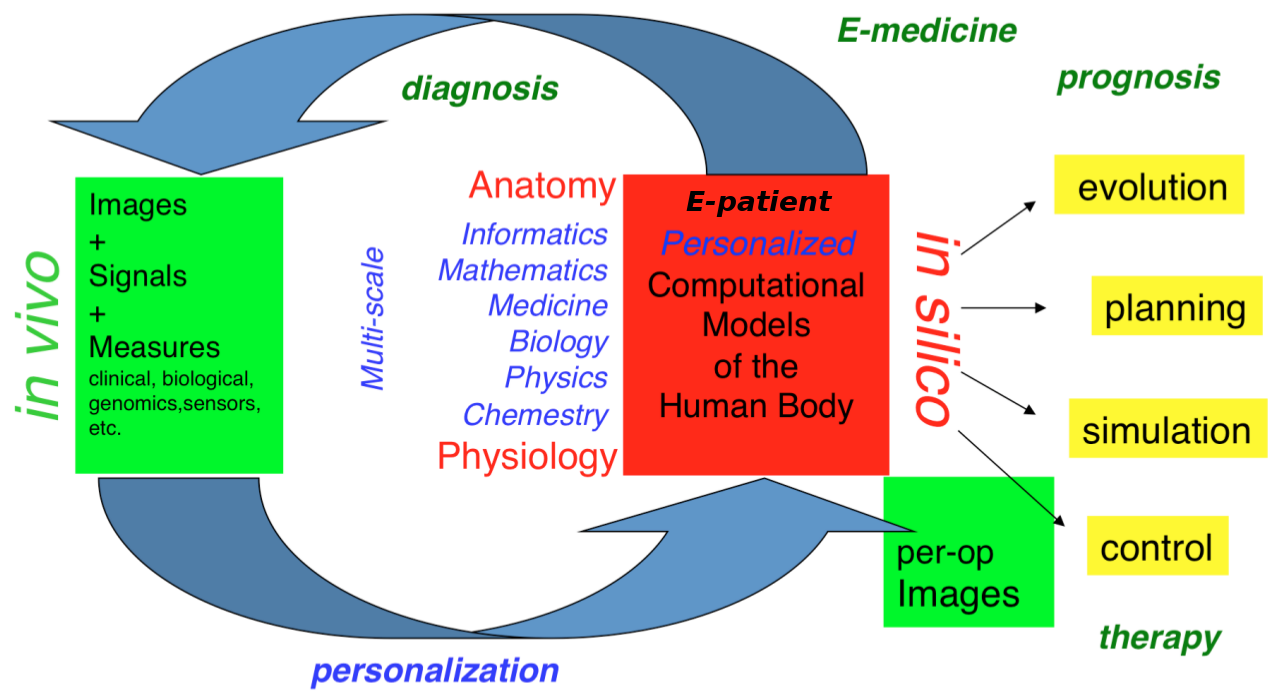
The e-patient for e-medicine
- the e-patient (or digital patient) is a set of computational models of the human body able to describe and simulate the anatomy and the physiology of the patient's organs and tissues, at various scales, for an individual or a population. The e-patient can be seen as a framework to integrate and analyze in a coherent manner the heterogeneous information measured on the patient from disparate sources: imaging, biological, clinical, sensors, ...
- e-medicine (or digital medicine) is defined as the computational tools applied to the e-patient to assist the physician and the surgeon in their medical practice, to assess the diagnosis/prognosis, and to plan, control and evaluate the therapy.
The models that govern the algorithms designed for e-patients and e-medicine come from various disciplines: computer science, mathematics, medicine, statistics, physics, biology, chemistry, etc. The parameters of those models must be adjusted to an individual or a population based on the available images, signals and data. This adjustment is called personalization and usually requires solving difficult inverse problems. The overall picture of the construction of the personalized e-patient for e-medicine was presented at the College de France through an inaugural lecture and a series of courses and seminars (fr), concluded by an international workshop.
2.2 Organization
The research organization in our field is often built on a virtuous triangle. On one vertex, academic research requires multidisciplinary collaborations associating informatics and mathematics to other disciplines: medicine, biology, physics, chemistry ... On a second vertex, a clinical partnership is required to help defining pertinent questions, to get access to clinical data, and to clinically evaluate any proposed solution. On the third vertex, an industrial partnership can be introduced for the research activity itself, and also to transform any proposed solution into a validated product that can ultimately be transferred to the clinical sites for an effective use on the patients.
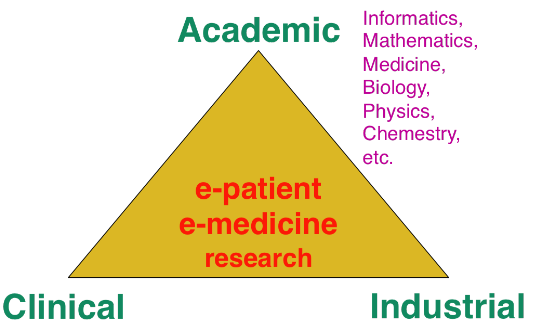
A pluridisciplinary research triangle
Keeping this triangle in mind, we choose our research directions within a virtuous circle: we look at difficult problems raised by our clinical or industrial partners, and then try to identify some classes of generic fundamental/theoretical problems associated to their resolution. We also study some fundamental/theoretical problems per se in order to produce fundamental scientific advances that can help in turn to promote new applications.
3 Research program
3.1 Introduction
Our research objectives are organized along 5 scientific axes:
- Biomedical Image Analysis & Machine Learning
- Imaging & Phenomics, Biostatistics
- Computational Anatomy, Geometric Statistics
- Computational Physiology & Image-Guided Therapy
- Computational Cardiology & Image-Based Cardiac Interventions
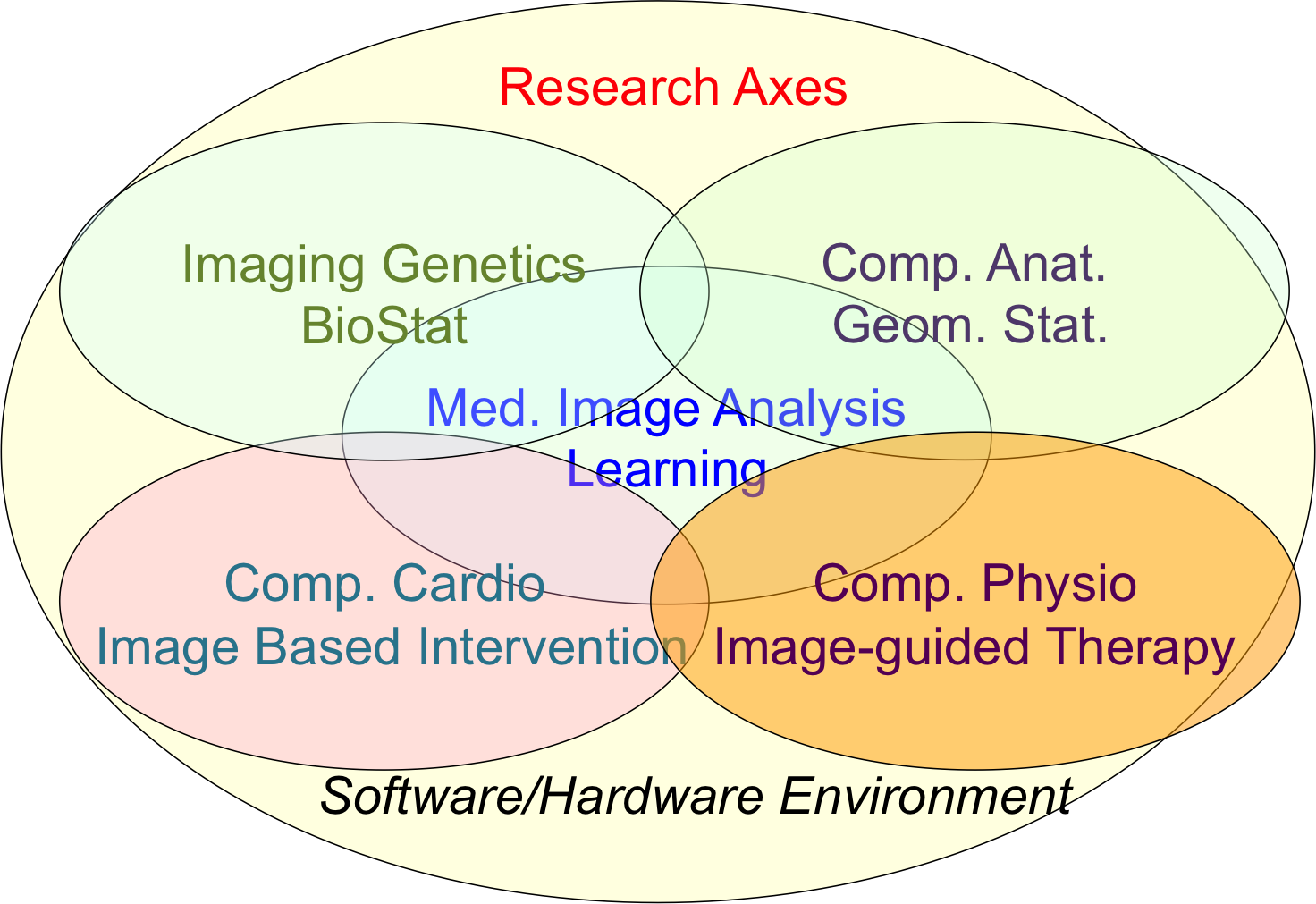
Epione's five main research axes
For each scientific axis, we introduce the context and the long term vision of our research.
3.2 Biomedical Image Analysis & Machine Learning
The long-term objective of biomedical image analysis is to extract, from biomedical images, pertinent information for the construction of the e-patient and for the development of e-medicine. This relates to the development of advanced segmentation and registration of images, the extraction of image biomarkers of pathologies, the detection and classification of image abnormalities, the construction of temporal models of motion or evolution from time-series of images, etc.
In addition, the growing availability of very large databases of biomedical images, the growing power of computers and the progress of machine learning (ML) approaches have opened up new opportunities for biomedical image analysis.
This is the reason why we decided to revisit a number of biomedical image analysis problems with ML approaches, including segmentation and registration problems, automatic detection of abnormalities, prediction of a missing imaging modality, etc. Not only those ML approaches often outperform the previous state-of-the-art solutions in terms of performances (accuracy of the results, computing times), but they also tend to offer a higher flexibility like the possibility to be transferred from one problem to another one with a similar framework. However, even when successful, ML approaches tend to suffer from a lack of explanatory power, which is particularly annoying for medical applications. We also plan to work on methods that can interpret the results of the ML algorithms that we develop.
3.3 Imaging & Phenomics, Biostatistics
The human phenotype is associated with a multitude of heterogeneous biomarkers quantified by imaging, clinical and biological measurements, reflecting the biological and patho-physiological processes governing the human body, and essentially linked to the underlying individual genotype. In order to deepen our understanding of these complex relationships and better identify pathological traits in individuals and clinical groups, a long-term objective of e-medicine is therefore to develop the tools for the joint analysis of this heterogeneous information, termed Phenomics, within the unified modeling setting of the e-patient.
To date the most common approach to the analysis of the joint variation between the structure and function of organs represented in medical images, and the classical -omics modalities from biology, such as genomics or lipidomics, is essentially based on the massive univariate statistical testing of single candidate features out of the many available. This is for example the case of genome-wide association studies (GWAS) aimed at identifying statistically significant effects in pools consisting of up to millions of genetics variants. Such approaches have known limitations such as multiple comparison problems, leading to underpowered discoveries of significant associations, and usually explain a rather limited amount of data variance. Although more sophisticated machine learning approaches have been proposed, the reliability and generalization of multivariate methods is currently hampered by the low sample size relatively to the usually large dimension of the parameters space.
To address these issues this research axis investigates novel methods for the integration of this heterogeneous information within a parsimonious and unified multivariate modeling framework. The cornerstone of the project consists in achieving an optimal trade-off between modeling flexibility and ability to generalize on unseen data by developing statistical learning methods informed by prior information, either inspired by "mechanistic" biological processes, or accounting for specific signal properties (such as the structured information from spatio-temporal image time series). Finally, particular attention will be paid to the effective exploitation of the methods in the growing Big Data scenario, either in the meta-analysis context, or for the application in large datasets and biobanks.
Federated learning in multi-centric studies. The current research scenario is characterized by medium/small scale (typically from 50 to 1000 patients) heterogeneous datasets distributed across centres and countries. The straightforward extension of learning algorithms successfully applied to big data problems is therefore difficult, and specific strategies need to be envisioned in order to optimally exploit the available information. To address this problem, we focus on learning approaches to jointly model clinical data localized in different centres. This is an important issue emerging from recent large-scale multi-centric imaging-genetics studies in which partners can only share model parameters (e.g. regression coefficients between specific genes and imaging features), as represented for example by the ENIGMA imaging-genetics study, led by the collaborators at University of Southern California. This problem requires the development of statistical methods for federated model estimation, in order to access data hosted in different clinical institutions by simply transmitting the model parameters, that will be in turn updated by using the local available data. This approach is extended to the definition of stochastic optimization strategies in which model parameters are optimized on local datasets, and then summarized in a meta-analysis context. Finally, this project studies strategies for aggregating the information from heterogeneous datasets, accounting for missing modalities due to different study design and protocols. The developed methodology finds important applications within the context of Big Data, for the development of effective learning strategies for massive datasets in the context of medical imaging (such as with the UK biobank), and beyond.
3.4 Computational Anatomy, Geometric Statistics
Computational anatomy is an emerging discipline at the interface of geometry, statistics and image analysis which aims at developing algorithms to model and analyze the biological shape of tissues and organs. The goal is not only to establish generative models of organ anatomies across diseases, populations, species or ages but also to model the organ development across time (growth or aging) and to estimate their variability and link to other functional, genetic or structural information. Computational anatomy is a key component to support computational physiology and is evidently crucial for building the e-patient and to support e-medicine.
Pivotal applications include the spatial normalization of subjects in neuroscience (mapping all the anatomies into a common reference system) and atlas to patient registration to map generic knowledge to patient-specific data. Our objectives will be to develop new efficient algorithmic methods to address the emerging challenges described below and to generate precise specific anatomical model in particular for the brain and the heart.
The objects of computational anatomy are often shapes extracted from images or images of labels (segmentation). The observed organ images can also be modeled using registration as the random diffeomorphic deformation of an unknown template (i.e. an orbit). In these cases as in many other applications, invariance properties lead us to consider that these objects belong to non-linear spaces that have a geometric structure. Thus, the mathematical foundations of computational anatomy rely on statistics on non-linear spaces.
Geometric Statistics aim at studying this abstracted problem at the theoretical level. Our goal is to advance the fundamental knowledge in this area, with potential applications to new areas outside of medical imaging. Beyond the now classical Riemannian spaces, we aim at developing the foundations of statistical estimation on affine connection spaces (e.g. Lie groups), quotient and stratified metric spaces (e.g. orbifolds and tree spaces). In addition to the curvature, one of the key problem is the introduction of singularities at the boundary of the regular strata (non-smooth and non-convex analysis).
A second objective is to develop parametric and non-parametric dimension reduction methods in non-linear space. An important issue is to estimate efficiently not only the model parameters (mean point, subspace, flag) but also their uncertainty. We also want to quantify the influence of curvature and singularities on non-asymptotic estimation theory since we always have a finite (and often too limited) number of samples. A key challenge in developing such a geometrization of statistics will not only be to unify the theory for the different geometric structures, but also to provide efficient practical algorithms to implement them.
A third objective is to learn the geometry from the data. In the high dimensional but low sample size (small data) setting which is the common situation in medical data, we believe that invariance properties are essential to reasonably interpolate and approximate. New apparently antagonistic notions like approximate invariance could be the key to this interaction between geometry and learning.
Beyond the traditional statistical survey of the anatomical shapes that is developed in computational anatomy above, we intend to explore other application fields exhibiting geometric but non-medical data. For instance, applications can be found in Brain-Computer Interfaces (BCI), tree-spaces in phylogenetics, Quantum Physics, etc.
3.5 Computational Physiology & Image-Guided Therapy
Computational Physiology aims at developing computational models of human organ functions, an important component of the e-patient , with applications in e-medicine and more specifically in computer-aided prevention, diagnosis, therapy planning and therapy guidance. The focus of our research is on descriptive (allowing to reproduce available observations), discriminative (allowing to separate two populations), and above all predictive models which can be personalized from patient data including medical images, biosignals, biological information and other available metadata. A key aspect of this scientific axis is therefore the coupling of biophysical models with patient data which implies that we are mostly considering models with relatively few and identifiable parameters. To this end, data assimilation methods aiming at estimating biophysical model parameters in order to reproduce available patient data are preferably developed as they potentially lead to predictive models suitable for therapy planning.
Previous research projects in computational physiology have led us to develop biomechanical models representing quasi-static small or large soft tissue deformations (e.g. liver or breast deformation after surgery), mechanical growth or atrophy models (e.g. simulating brain atrophy related to neurodegenerative diseases), heat transfer models (e.g. simulating radiofrequency ablation of tumors), and tumor growth models (e.g. brain or lung tumor growth).
To improve the data assimilation of biophysical models from patient data, a long term objective of our research will be to develop joint imaging and biophysical generative models in a probabilistic framework which simultaneously describe the appearance and function of an organ (or its pathologies) in medical images. Indeed, current approaches for the personalization of biophysical models often proceed in two separate steps. In a first stage, geometric, kinematic or/ functional features are first extracted from medical images. In a second stage, they are used by personalization methods to optimize model parameters in order to match the extracted features. In this process, subtle information present in the image which could be informative for biophysical models is often lost which may lead to limited personalization results. Instead, we propose to develop more integrative approaches where the extraction of image features would be performed jointly with the model parameter fitting. Those imaging and biophysical generative models should lead to a better understanding of the content of images, to a better personalization of model parameters and also better estimates of their uncertainty.
3.6 Computational Cardiology & Image-Based Cardiac Interventions
Computational Cardiology has been an active research topic within the Computational Anatomy and Computational Physiology axes of the previous Asclepios project, leading to the development of personalized computational models of the heart designed to help characterizing the cardiac function and predict the effect of some device therapies like cardiac resynchronization or tissue ablation . This axis of research has now gained a lot of maturity and a critical mass of involved scientists to justify an individualized research axis of the new project Epione, while maintaining many constructive interactions with the 4 other research axes of the project. This will develop all the cardiovascular aspects of the e-patient for cardiac e-medicine.
The new challenges we want to address in computational cardiology are related to the introduction of new levels of modeling and to new clinical and biological applications. They also integrate the presence of new sources of measurements and the potential access to very large multimodal databases of images and measurements at various spatial and temporal scales.
4 Application domains
The main applications of our research are in the field of healthcare and more precisely the domain of digital medicine and biomedical data analysis. The axes of research presented above are related to many branches of medicine including cardiology, oncology, urology, neurology, otology, pneumology, radiology, surgery, dermatology, nuclear medicine. Within those branches, the applications cover the following different stages of medicine : prevention, diagnosis, prognosis, treatment.
5 Social and environmental responsibility
5.1 Footprint of research activities
An important activity of Epione is to introduce priors from clinical knowledge within data analysis, through geometric information, biophysical models, causality, etc. This enables to develop AI method requiring less data and computations. Therefore with a positive impact on the environmental footprint of epione research activity.
6 Highlights of the year
6.1 Awards
- The Personalized Computational Cardiology team, including Hervé Delingette and Maxime Sermesant, won the Prix de l'innovation Académie des Sciences - Inria - Dassault Systèmes.
- The PhD thesis of Yann Fraboni was awarded by the Doctoral School EDSTIC of the Premier Prix de la spécialité ATSI.
7 New software, platforms, open data
7.1 New software
7.1.1 CardiacSegmentationPropagation
-
Keywords:
3D, Segmentation, Cardiac, MRI, Deep learning
-
Functional Description:
Training of a deep learning model which is used for cardiac segmentation in short-axis MRI image stacks.
- Publication:
-
Authors:
Qiao Zheng, Hervé Delingette, Nicolas Duchateau, Nicholas Ayache
-
Contact:
Qiao Zheng
7.1.2 CardiacMotionFlow
-
Keywords:
3D, Deep learning, Cardiac, Classification
-
Functional Description:
Creation of a deep learning model for the motion tracking of the heart, extraction of characteristic quantities of the movement and shape of the heart to classify a sequence of cine-MRI cardiac images in terms of the types of pathologies (infarcted heart, dilated , hypertrophied, abnormality of the right ventricle).
- Publication:
-
Authors:
Qiao Zheng, Hervé Delingette, Nicholas Ayache
-
Contact:
Qiao Zheng
7.1.3 MedINRIA
-
Keywords:
Visualization, DWI, Health, Segmentation, Medical imaging
-
Scientific Description:
MedInria aims at creating an easily extensible platform for the distribution of research algorithms developed at Inria for medical image processing. This project has been funded by the D2T (ADT MedInria-NT) in 2010, renewed in 2012. A fast-track ADT was awarded in 2017 to transition the software core to more recent dependencies and study the possibility of a consortium creation.The Empenn team leads this Inria national project and participates in the development of the common core architecture and features of the software as well as in the development of specific plugins for the team's algorithm.
-
Functional Description:
medInria is a free software platform dedicated to medical data visualization and processing.
- URL:
-
Contact:
Florent Leray
-
Participants:
Maxime Sermesant, Olivier Commowick
-
Partners:
HARVARD Medical School, IHU - LIRYC, NIH
7.1.4 GP-ProgressionModel
-
Name:
GP progression model
-
Keywords:
Data modeling, Data visualization, Data integration, Machine learning, Biostatistics, Statistical modeling, Medical applications, Evolution, Brain, Uncertainly, Uncertainty quantification, Alzheimer's disease, Probability, Stochastic models, Stochastic process, Trajectory Modeling, Marker selection, Health, Statistic analysis, Statistics, Bayesian estimation
-
Functional Description:
Disease progression modeling (DPM) of Alzheimer's disease (AD) aims at revealing long term pathological trajectories from short term clinical data. Along with the ability of providing a data-driven description of the natural evolution of the pathology, DPM has the potential of representing a valuable clinical instrument for automatic diagnosis, by explicitly describing the biomarker transition from normal to pathological stages along the disease time axis.
In this software we reformulate DPM within a probabilistic setting to quantify the diagnostic uncertainty of individual disease severity in an hypothetical clinical scenario, with respect to missing measurements, biomarkers, and follow-up information. The proposed formulation of DPM provides a statistical reference for the accurate probabilistic assessment of the pathological stage of de-novo individuals, and represents a valuable instrument for quantifying the variability and the diagnostic value of biomarkers across disease stages.
This software is based on the publication:
Probabilistic disease progression modeling to characterize diagnostic uncertainty: Application to staging and prediction in Alzheimer's disease. Marco Lorenzi, Maurizio Filippone, Daniel C. Alexander, Sebastien Ourselin Neuroimage. 2019 Apr 15,190:56-68. doi: 10.1016/j.neuroimage.2017.08.059. Epub 2017 Oct 24. HAL Id : hal-01617750 https://hal.archives-ouvertes.fr/hal-01617750/
-
Release Contributions:
- New interface and output - Completely based on Pytorch
- URL:
- Publication:
-
Contact:
Marco Lorenzi
-
Participant:
Marco Lorenzi
7.1.5 Music
-
Name:
Multi-modality Platform for Specific Imaging in Cardiology
-
Keywords:
Medical imaging, Cardiac Electrophysiology, Computer-assisted surgery, Cardiac, Health
-
Functional Description:
MUSIC is a software developed by the Asclepios research project in close collaboration with the IHU LIRYC in order to propose functionalities dedicated to cardiac interventional planning and guidance. This includes specific tools (algorithms of segmentation, registration, etc.) as well as pipelines. The software is based on the MedInria platform.
- URL:
-
Contact:
Maxime Sermesant
-
Participants:
Florent Collot, Mathilde Merle, Maxime Sermesant
-
Partner:
IHU- Bordeau
7.1.6 SOFA
-
Name:
Simulation Open Framework Architecture
-
Keywords:
Real time, Multi-physics simulation, Medical applications
-
Functional Description:
SOFA is an Open Source framework primarily targeted at real-time simulation, with an emphasis on medical simulation. It is mostly intended for the research community to help develop new algorithms, but can also be used as an efficient prototyping tool. Based on an advanced software architecture, it allows the creation of complex and evolving simulations by combining new algorithms with algorithms already included in SOFA, the modification of most parameters of the simulation (deformable behavior, surface representation, solver, constraints, collision algorithm etc.) by simply editing an XML file, the building of complex models from simpler ones using a scene-graph description, the efficient simulation of the dynamics of interacting objects using abstract equation solvers, the reuse and easy comparison of a variety of available methods.
-
News of the Year:
The new version v20.06 has been released including new elements on SoftRobots + ModelOrderReduction integration, in addition to an improved architecture and lots of cleans and bugfixes.
- URL:
- Publication:
-
Contact:
Hugo Talbot
-
Participants:
Christian Duriez, François Faure, Hervé Delingette, Stephane Cotin, Hugo Talbot, Maud Marchal
-
Partners:
IGG, CRIStAL
7.1.7 geomstats
-
Name:
Computations and statistics on manifolds with geometric structures
-
Keywords:
Geometry, Statistic analysis
-
Scientific Description:
Geomstats is an open-source Python package for computations and statistics on manifolds. The package is organized into two main modules: “geometry“ and “learning“.
The module `geometry` implements concepts in differential geometry, and the module `learning` implements statistics and learning algorithms for data on manifolds.
The goal is to provide an easily accessible library for learning algorithms on Riemannian manifolds.
-
Functional Description:
GeomStats is a Python package that performs computations on manifolds such as hyperspheres, hyperbolic spaces, spaces of symmetric positive definite matrices and Lie groups of transformations. It provides efficient and extensively unit-tested implementations of these manifolds, together with useful Riemannian metrics and associated Exponential and Logarithm maps. The corresponding geodesic distances provide a range of intuitive choices of Machine Learning loss functions. The operations implemented in GeomStats are available with different computing backends such as numpy, autograd, pytorch, and tensorflow.
-
Release Contributions:
Major refactoring of the library with automated tests.
-
News of the Year:
A workshop was organized at GSI23, presentations about the package were done at several conferences/workshops (CSE23 (Amsterdam), Math in the Mine (Tende)) and invited seminars (Mox-Polimi (Milano), FEUP/INEGI (Porto)), contributing to the diffusion of the project. A major refactoring regarding testing was finished (all the tests were rewritten from scratch), strongly contributing to the increase of the robustness and correctness of the library. Several other smaller refactorings were done in order to increase the ease of use and development of the implemented/to implement mathematical concepts (e.g. introduction of the concept of diffeomorphism). New spaces and metrics were introduced, in particular those related with SPD/full-rank correlation matrices. A numerics module was designed and implemented, in order to allow quick prototyping and benchmarking of numerical methods. The design and implementation of geodesic metric spaces (which include stratified spaces) was carried on. A new way of sequentially adding mathematical structure to a given space started being designed.
- URL:
- Publications:
-
Contact:
Xavier Pennec
-
Participants:
Olivier Bisson, Nicolas Guigui, Xavier Pennec, Yann Thanwerdas, Nina Miolane, Luis Pereira, Anna Calissano, Elodie Maignant, Nina Miolane, Alice Le Brigant
-
Partners:
University of California Santa Barbara, Université Panthéon-Sorbonne
7.1.8 MC-VAE
-
Name:
Multi Channel Variational Autoencoder
-
Keywords:
Machine learning, Artificial intelligence, Medical applications, Dimensionality reduction, High Dimensional Data, Unsupervised learning, Heterogeneity
-
Scientific Description:
Interpretable modeling of heterogeneous data channels is essential in medical applications, for example when jointly analyzing clinical scores and medical images. Variational Autoencoders (VAE) are powerful generative models that learn representations of complex data. The flexibility of VAE may come at the expense of lack of interpretability in describing the joint relationship between heterogeneous data. To tackle this problem, this software extends the variational framework of VAE to introduce sparsity of the latent representation, as well as interpretability when jointly accounting for latent relationships across multiple channels. In the latent space, this is achieved by constraining the variational distribution of each channel to a common target prior. Parsimonious latent representations are enforced by variational dropout. Experiments on synthetic data show that our model correctly identifies the prescribed latent dimensions and data relationships across multiple testing scenarios. When applied to imaging and clinical data, our method allows to identify the joint effect of age and pathology in describing clinical condition in a large scale clinical cohort.
-
Functional Description:
This software implements the work published in the paper "Sparse Multi-Channel Variational Autoencoder for the Joint Analysis of Heterogeneous Data" presented at the conference ICML 2019 (Long Beach, California, USA).
The software extends classical variational autoencoders by identifying a joint latent code associated to heterogeneous data represented in different channels. The software is implemented in Python and is based on Pytorch. It can be applied to any kind of data arrays, and provides functions for optimization, visualization and writing of the modeling results.
-
Release Contributions:
First release
- URL:
-
Contact:
Luigi Antelmi
-
Participants:
Luigi Antelmi, Marco Lorenzi, Nicholas Ayache
-
Partner:
CoBteK
7.1.9 SOFA-CardiacReduction
-
Keywords:
Simulation, 3D modeling, Model Order Reduction, Cardiac
-
Scientific Description:
Modification of a finite element deformation model : meshless approach and frame-based description, reduction in the number of affine degrees of freedom and integration points.
-
Functional Description:
This SOFA plugin is intented to build a reduced model for deformable solids (especially cardiac simulations).
- Publication:
-
Contact:
Gaetan Desrues
-
Participants:
Gaetan Desrues, Hervé Delingette, Maxime Sermesant
7.1.10 Fed-BioMed
-
Name:
A general software framework for federated learning in healthcare
-
Keywords:
Federated learning, Medical applications, Machine learning, Distributed Applications, Deep learning
-
Scientific Description:
While data in healthcare is produced in quantities never imagined before, the feasibility of clinical studies is often hindered by the problem of data access and transfer, especially regarding privacy concerns. Federated learning allows privacy-preserving data analyses using decentralized optimization approaches keeping data securely decentralized. There are currently initiatives providing federated learning frameworks, which are however tailored to specific hardware and modeling approaches, and do not provide natively a deployable production-ready environment. To tackle this issue, Fed-BioMed proposes an open-source federated learning frontend framework with application in healthcare. Fed-BioMed framework is based on a general architecture accommodating for different models and optimization methods
-
Functional Description:
The project is based on the development of a distributed software architecture, and the establishment of a server instance from which remote experiments are triggered on the clients sites. The software is distributed to the client's sites, allowing to run machine learning models on the local data. Model parameters are then transmitted to the server for federated aggregation.
Fed-BioMed finds application in all projects based on the development of learning models for multi-centric studies.
-
Release Contributions:
Fed-BioMed is based on Python and Pytorch. The software was recently revised (under an ADT) to adopt the libraries Pygrid and Pysyft.
- URL:
- Publication:
-
Authors:
Marco Lorenzi, Santiago Smith Silva Rincon, Marc Vesin, Tristan Cabel, Irene Balelli, Andréa Senacheribbe, Carlos Zubiaga Pena, Jonathan Levy
-
Contact:
Marco Lorenzi
7.1.11 EchoFanArea
-
Name:
delineation of the border of the fan in ultrasound
-
Keywords:
Ultrasound fan area, Deep learning, Statistics, Image processing
-
Functional Description:
This software allows the delimitation of the acquisition cone in ultrasound imaging and the inpainting of annotations (lines, characters) inside the cone. It allows both the perfect de-identification of the images but also to standardize the content of the images. It relies on a parametric probabilistic approach to generate a training dataset with region of interest (ROI) segmentation masks. This data will then be used to train a deep U-Net network to perform the same task in a supervised manner, thus considerably reducing the calculation time of the method, one hundred and sixty times faster. These images are then processed with existing filling methods to remove annotations present within the signal area.
- URL:
- Publication:
-
Authors:
Hind Dadoun, Hervé Delingette, Nicholas Ayache, Anne-Laure Rousseau
-
Contact:
Hind Dadoun
-
Partner:
Nhance
7.1.12 ProMFusion
-
Keywords:
Image segmentation, Data fusion
-
Functional Description:
Code related to the paper "Robust Fusion of Probability Maps" by Benoît Audelan, Dimitri Hamzaoui, Sarah Montagne, Raphaële Renard-Penna and Hervé Delingette. The proposed approach allows to fuse probability maps in a robust manner with a spatial regularization of the consensus.
- URL:
- Publication:
-
Contact:
Benoit Audelan
-
Participants:
Benoit Audelan, Hervé Delingette, Dimitri Hamzaoui
7.1.13 SimulAD
-
Name:
Disease progression modeling for clinical intervention simulation
-
Keywords:
Data modeling, Clinical analysis, Clinical trial simulator, Alzheimer's disease, Pytorch, Variational Autoencoder, Ordinary differential equations
-
Scientific Description:
Recent failures of clinical trials in Alzheimer’s Disease underline the critical importance of identifying optimal intervention time to maximize cognitive benefit. While several models of disease progression have been proposed, we still lack quantitative approaches simulating the effect of treatment strategies on the clinical evolution. In this work, we present a data-driven method to model dynamical relationships between imaging and clinical biomarkers. Our approach allows simulating intervention at any stage of the pathology by modulating the progression speed of the biomarkers, and by subsequently assessing the impact on disease evolution.
-
Functional Description:
A machine-learning framework allowing to simulate the impact of intervention on the long-term progression of imaging and clinical biomarkers from collections of healthcare data
-
Release Contributions:
Most recent version available at https://gitlab.inria.fr/epione/simulad/-/tree/master/
- Publication:
-
Contact:
Marco Lorenzi
-
Participants:
Clément Abi Nader, Marco Lorenzi, Nicholas Ayache, Philippe Robert
-
Partner:
Université Côte d'Azur (UCA)
7.2 Open data
Hervé Delingette is the referent for the management of research data at the Inria center of Université Côte d'Azur. He is acting among a national network of referents located in each Inria center who provides a forum for close dialogue with scientists, to gather needs and expectations, and to provide advice and disciplinary expertise.
He gave a 1h presentation on open research data management to PhD students during a Master class on Open Science at Université Côte d'Azur on May 4th.
8 New results
8.1 Medical Image Analysis & Machine Learning
8.1.1 AI-based Real-time Diagnostic Aid for Abdominal Organs in Ultrasound
This work has been supported by the French government, through the 3IA Côte d'Azur Investments in the Future project managed by the National Research Agency (ANR) with the reference number ANR-19-P3IA-0002. It has been also supported by the Health Data Hub and the data warehouse of the Paris hospitals.
Keywords:
Participants: Hind Dadoun [Correspondant], Hervé Delingette, Nicholas Ayache, Anne-Laure Rousseau.
This work of the computer-assisted screening of abdominal organs in ultrasound has been performed in collaboration with the NHance NGO and the Paris hospitals (Dr Anne-Laure Rousseau).
- We explored self-supervised and semi-supervised learning methods to leverage unlabeled data for abdominal organ classification in the presence of very few labeled data 14.
- We have also explored the development of joint representation learning from French radiological reports and ultrasound images to improve the detection of diseased abdominal organs in ultrasound 32.
8.1.2 Machine Learning for MR-TRUS Prostate Image Fusion
This work has been supported by the French government, through the 3IA Côte d'Azur Investments in the Future project managed by the National Research Agency (ANR) with the reference number ANR-19-P3IA-0002.
Keywords:
Participants: Zhijie Fang [Correspondant], Hervé Delingette, Nicholas Ayache, Eric Gaudard [Koelis], Paul Wiegel [Koelis].
This is a work performed in collaboration with the Koelis Company (E. Gaudard and P. Wegiel).
- Development of an algorithm to detect anatomical landmarks to initialize the registration of prostate Ultra Sounds (US) and Magnetic Resonance (MR) images 40.
8.1.3 Prostate and Humerus Shape Analysis
Keywords:
Participants: Samy Ferrat [Correspondant], Herve Delingette, Marc-Olivier Gauci.
During the Master internship of Samy Ferrat, and within a collaboration with University Hospital of Nice (Pr M-O. Gauci) and the Paris hospitals (Pr R. Penna, Hospital Pitié Salpétrière), we have studied the variability of anatomical shapes (Figure 4) :
- We have evaluated the impact of the shape representations (binary or intensity masks, clamped distance maps) on the creation of latent representations of the shapes of organs such as prostate or humerus.
- We have tested both linear (PCA or probabilistic PCA) or non-linear (Variational Auto-encoders) latent representation models.
- We have developed a processing pipeline for humerus segmentation from CT scan images.
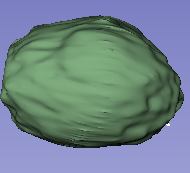
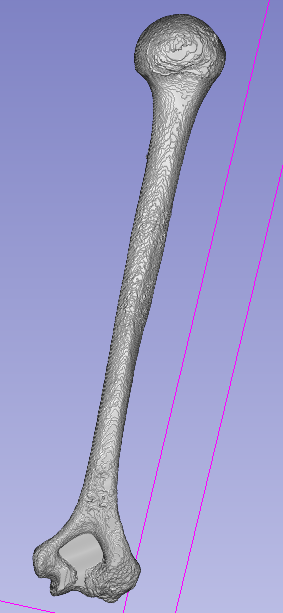
(a) Prostate Reconstruction from a latent representation of a variational encoder. (b) Segmented humerus from CT image.
8.1.4 Automatic Segmentation of the Vascular System to Enhance AI-based Decision Support System for Peripheral Artery Disease
This work was funded by 3IA Côte d'Azur.
Keywords:
Participants: Lisa Guzzi [Correspondant], Hervé Delingette, Juliette Raffort-Lareyre, Maria A. Zuluaga.
The aim of this works is to address the underdiagnosis and difficulty in surgery intervention planning of Peripheral Artery Disease (PAD) using Computed Tomography Angiography (CTA). Leveraging AI, the goal is to develop tools for:
- Automatic artery segmentation
- Anatomical and disease characterization to guide diagnosis
- Severity quantification
as illustrated in Figure 5. A review paper 21 focusing on AI's potential for vascular clinical decision-making was also produced.
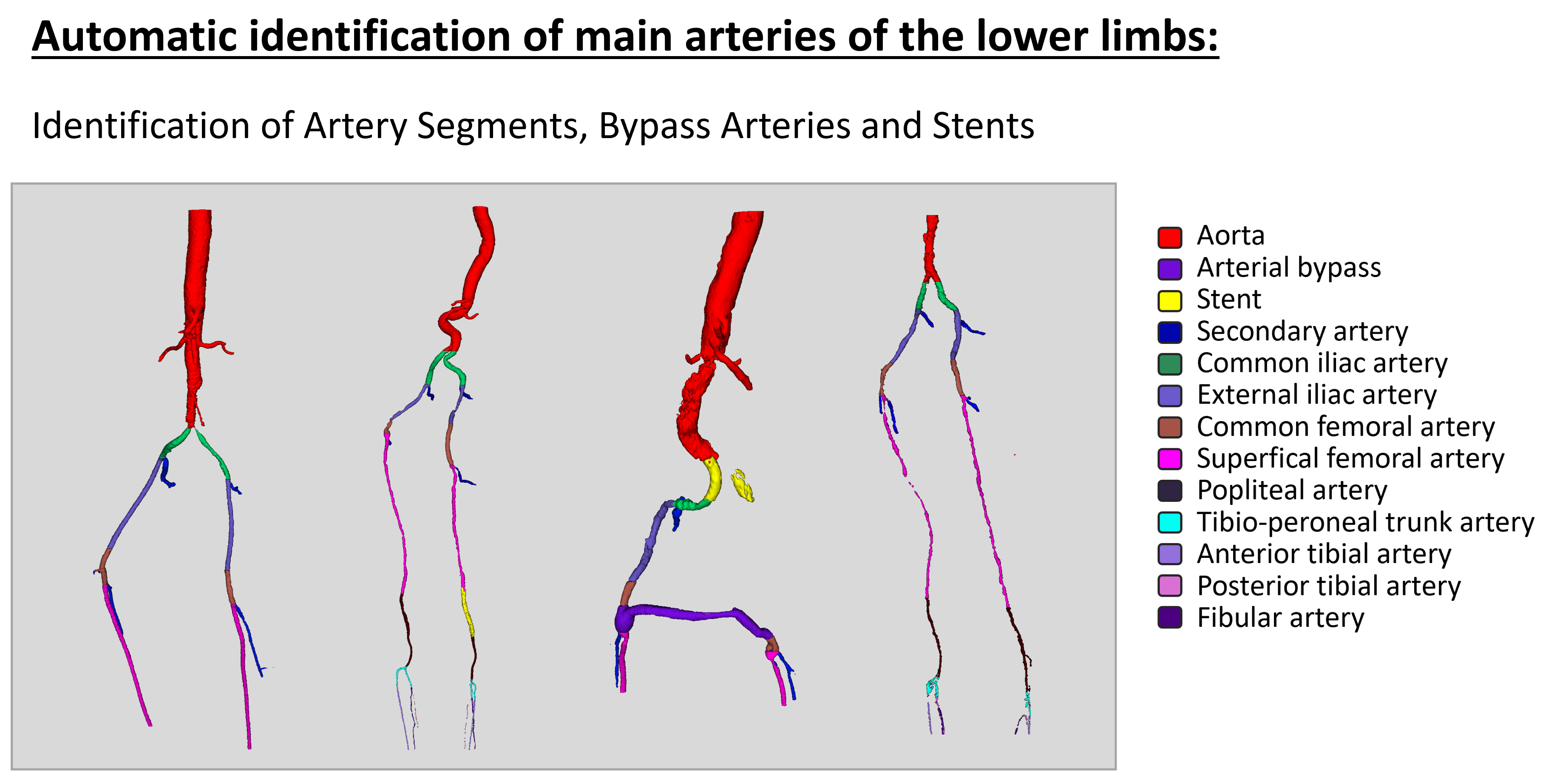
Overview of the project on automatic segmentation of CT images for peripheral artery diseases
8.1.5 AI-Based Diagnosis of Prostate Cancer from Multiparametric MRI
This work has been supported by funding from the 3IA Côte d'Azur Investments, UniCA DS4H graduate school, by the Health Data Center of the AP-HP (Assistance Publique-Hôpitaux de Paris) and by the Alain Rahmouni Grant from the French Radiology Society-CERF
Keywords:
Participants: Dimitri Hamzaoui [Correspondant], Sarah Montagne, Sebastien Moliere, Raphaële Renard-Penna, Nicholas Ayache, Herve Delingette.
The aim of this work is to study the impact of inter-rater variability on prostate segmentation, in order to improve prostate cancer detection. To do so, we mainly worked on two projects:
- First, we developed a new method to produce binary and probabilistic segmentation consensuses from binary segmentations (see Figure 6 (a)). The method is based on an iterative optimization of the Frechet Variance for specific metrics. In particular, the choice of overlap-based metrics allow us to obtain a background-independent result 17.
- Second, we made an extensive study on how the number of raters can impact the inter-rater variability on prostate segmentation (see Figure 6 (b)). This study was made with seven radiologists with various levels of experience. We observed that using 3 segmentations there was a tipping point in variability for both pairwise and consensus comparisons. Therefore we retained 3 segmentations as an appropriate number for such comparisons 22.
These works have been published in the PhD manuscript of Dimitri Hamzaoui 48.

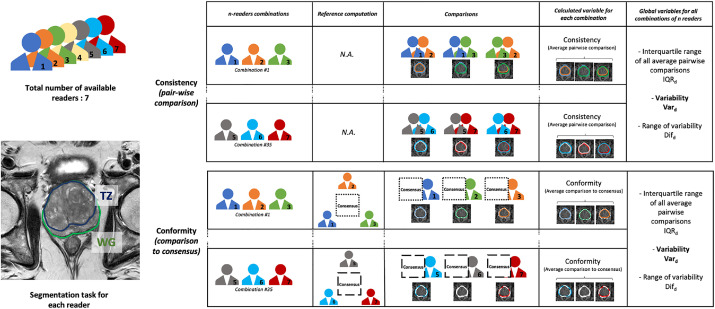
(a) Principle of the new segmentation consensus method. (b) Methodology of the inter-rater variability study.
8.1.6 Thyrosonics
This project has received funding through BoostUrCAreer from the European Union's Horizon 2020 research and innovation program under grant agreement Nr. 847581. It has been co-funded by the Region Provence-Alpes-Côte d'Azur and IDEX UCA
Keywords:
Participants: Hari Sreedhar [Correspondant], Hervé Delingette, Guillaume Lajoinie, Charles Raffaelli.
- This project investigates thyroid ultrasound machine learning applications in the context of annotation difficulties and the physics of nonlinear wave propagation.
- A weighted active learning selection strategy (Figure 7) was presented as a poster at the 2023 MICCAI Workshop on Data Augmentation, Labeling, and Imperfections 36. It introduces a rigged draw strategy for active learning which is an uncertainty-weighted selection approach suited for supervised and semi-supervised learning.
- Elements of the work were presented at the 2023 Atelier Thyroïde de Sète (May 27) and at the Club Thyroïde Côte d'Azur (Nov 28)
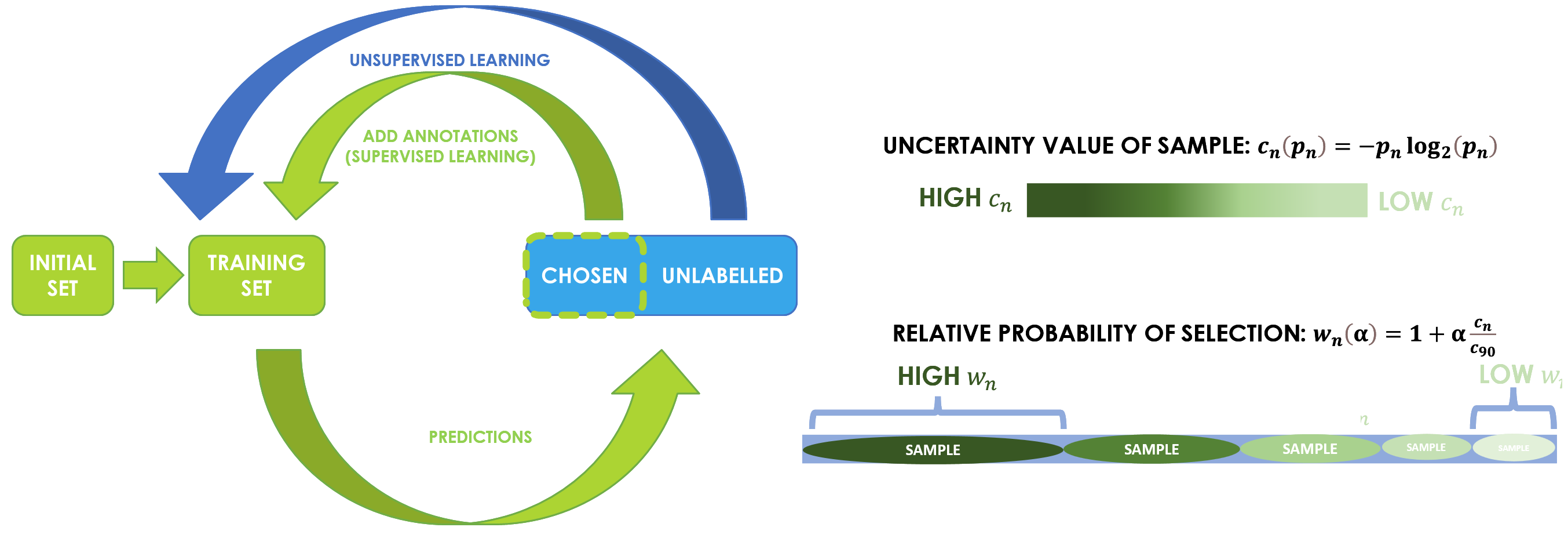
Active learning cycle from 36 on left, with the weighted rigged draw strategy on the right.
8.1.7 AI-based Selection of Imaging and Biological Markers Predictive of Treatment Response in Lung Cancer
This work has been supported by the French government, through the 3IA Côte d'Azur Investments in the Future project managed by the National Research Agency (ANR) with the reference number ANR-19-P3IA-0002.
Keywords:
Participants: Paul Tourniaire [Correspondant], Hervé Delingette, Nicholas Ayache, Marius Ilié, Paul Hofman.
- Thesis defended: AI-based selection of imaging and biological markers predictive of therapy response in lung cancer 54.
- Development of MS-CLAM, an algorithm for the use of mixed supervision for the improvement of classification and localization of tumors with few labels 26.
- Histology-based survival prediction to select patients for an immunotherapy treatment for lung cancer patients (Figure 8).
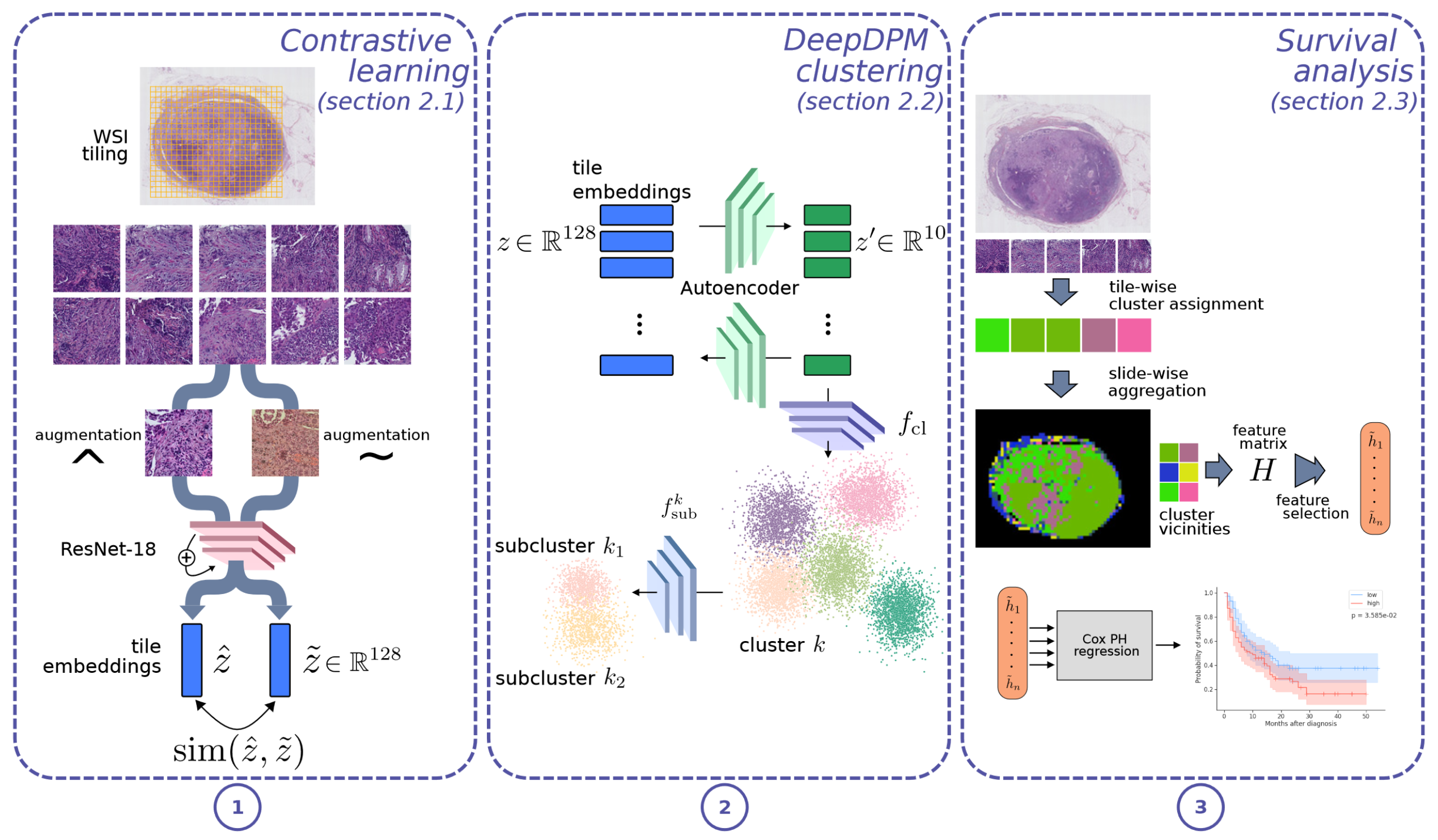
The workflow developed to predict post-immunotherapy survival among patients suffering from lung cancer, using pathology slides.
8.2 Imaging & Phenomics, Biostatistics
8.2.1 Development of Genome-to-Phenome Association Methods Using Biologically Inspired Constraints
This work was funded by the grant ANR PARIS-15087 and ANR MITOMICS 2022000174.
Keywords:
Participants: Marie Deprez [Correspondant], Marco Lorenzi.
In the study of rare mitochondrial diseases, many analysis have been performed on mitochondrial DNA to identify rare variants and evaluate their pathogenicity. Yet, only a small number of studies focus on the co-occurences between multiple mitoDNA variants and/or nuclear variants and their impact on the pathological traits. Our participation in the MITOMICS project extends our previous work on the joint analysis of genomic and phenotypic data to uncover the genetics underpinning complex pathological traits. This project is developed following multiple steps :
- Understanding the biological differences between mitochondrial and nuclear DNA (see Figure 9). A Mitochondrial DNA (mtDNA) is circular, present in multiple copies and its maintenance is controlled both by itself and nuclear DNA.
- Study the biological / functional constraints that can be used for the prioritization of mtDNA variants, Figure 9.B. Including variants in protein-coding genes, but also in transfer RNAs (tRNAs) and ribosomal RNAs (rRNAs).
- Some administrative work was also required to approve data security and management due to the specific sensibility of genomic data.
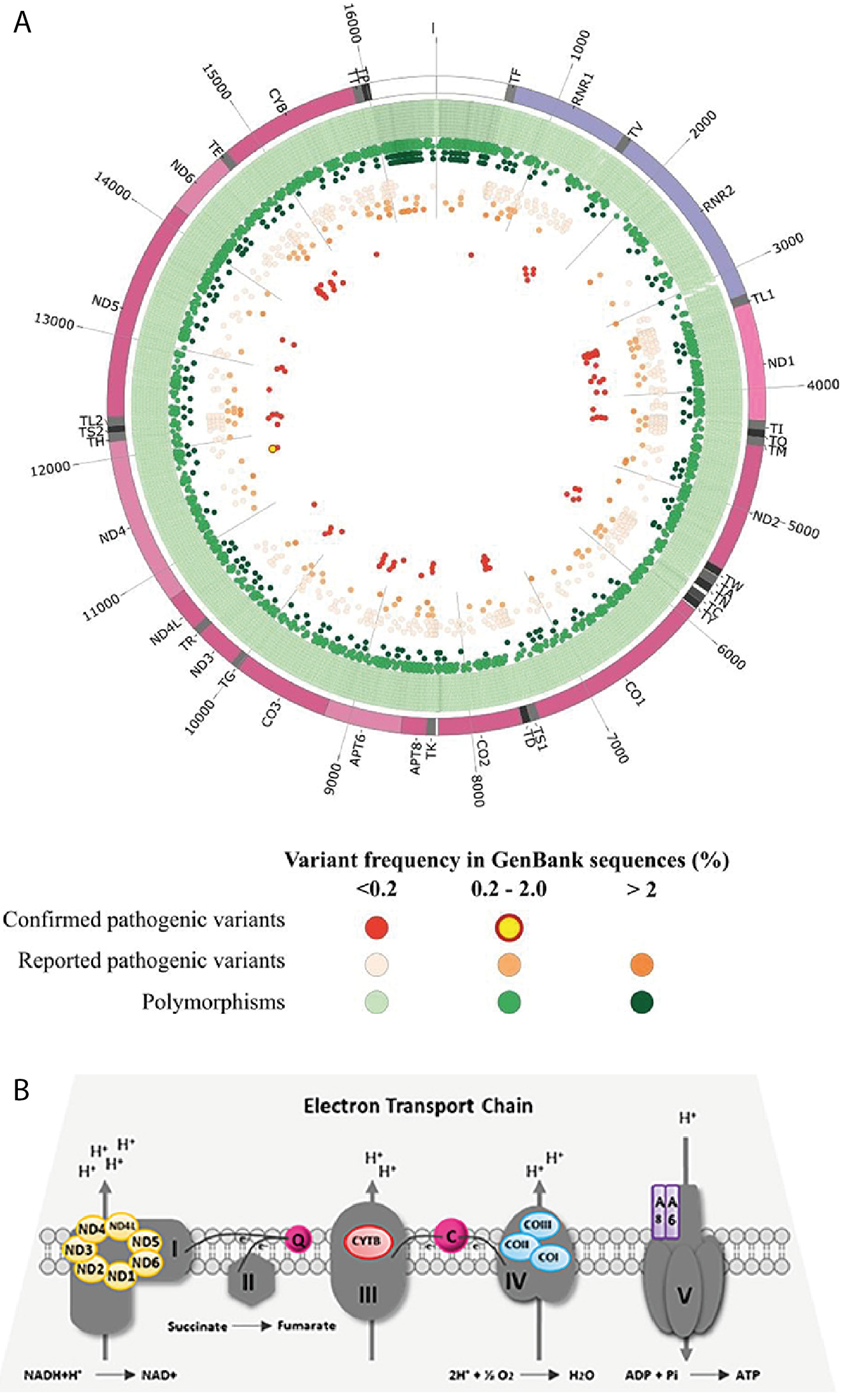
(A) Graphical representation of human mitochondrial variations. The outer circle depicts the mitochondrial genome with annotated tRNAs (gray), rRNAs (purple), protein-coding genes and non-coding regions (white). In the inner circle each point represents an mtDNA variant reported in Genbank collected from Mitomap according to the reported variant status (polymorphisms in green, reported pathogenic in orange and confirmed pathogenic in red) and frequency. (B) Mitochondrial DNA encodes 13 integral subunits of the electron transport chain. Figure adapted from Jones et al. 2021..
8.2.2 Exploring Latent Dynamical Models for the Analysis of High-dimensional and Heterogeneous Data
This work was funded by 3IA Côte d'Azur.
Keywords:
Participants: Etrit Haxholli [Correspondent], Marco Lorenzi.
Density estimation is the statistical process of constructing a probabilistic model that represents the distribution of a given dataset. Our contributions to the field of density estimation include:
- We defined a novel theoretical framework for the robust estimation of the tails of distributions in complex setting.
- We exploit the property of diffusion probabilistic models wherein scores describing the diffusion process can be optimized independently from each other 42. We demonstrate that exploiting this property can substantially reduce training time and enhance density estimation performance, as shown in Figure 10.
- Defended and published the PhD thesis of Etrit Haxholli entitled "Scalable and Flexible Density Estimation for Complex Data Distributions" 49.
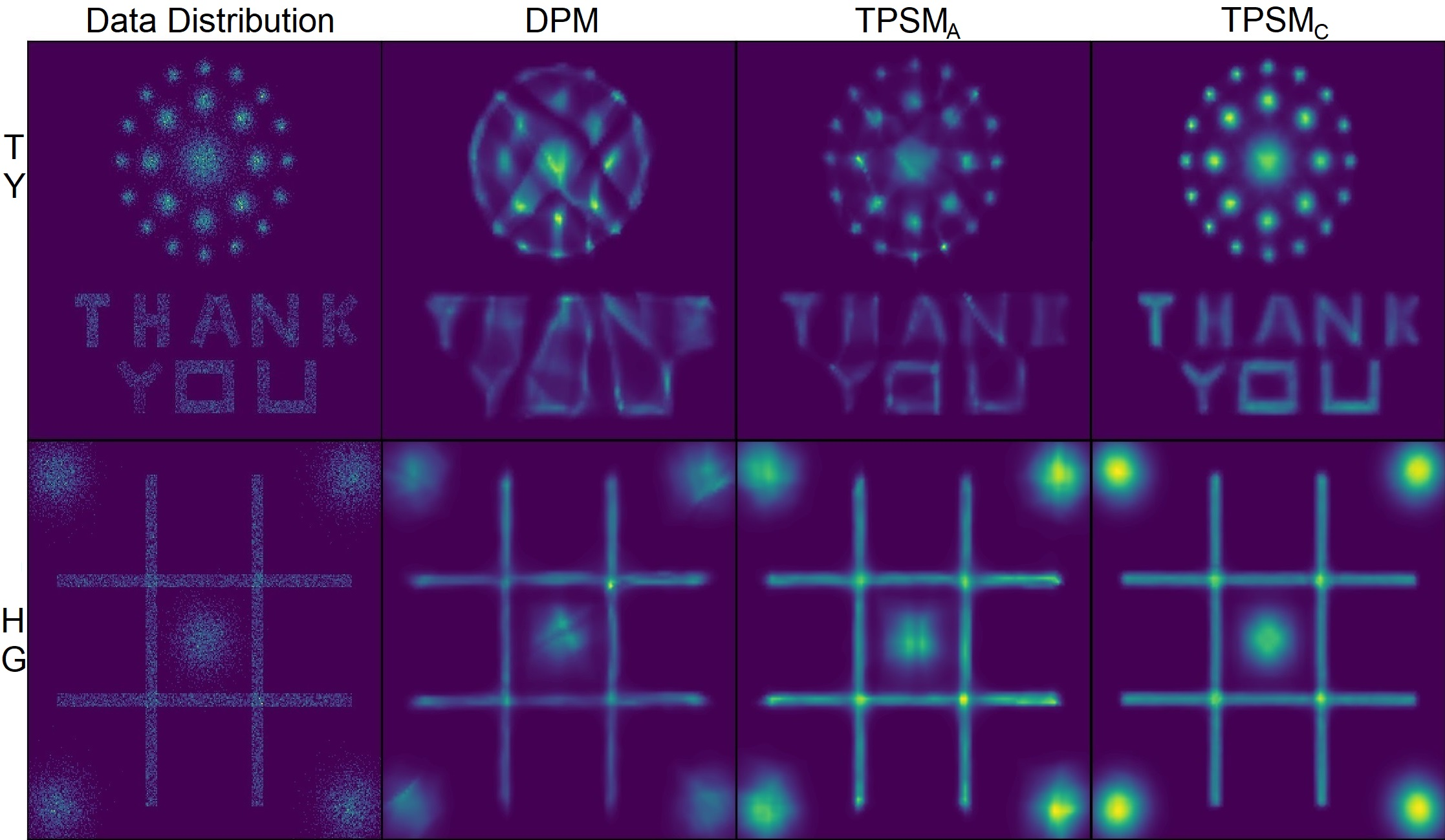
Probability density modeling capabilities as a function of the number of groups of scores learned independently which increases from left to right.
8.3 Computational Anatomy & Geometric Statistics
8.3.1 Riemannian and Sub-riemannian Methods for Dimension Reduction
This work was funded by the ERC grant #786854 G-Statistics from the European Research Council under the European Union's Horizon 2020 research and innovation program.
Keywords:
Participants: Morten Akhoj Pedersen [Correspondant], Xavier Pennec, James Benn, Stefan Sommer [UCPH, DK].
The PhD thesis of Morten Akhoj Pedersen 52 proposes two new methods for dimension reduction based on differential geometry.
- We generalize a method used in evolutionary biology, phylogenetic principal component analysis, to data on a Riemannian manifold, e.g. shape data. This has been published in 28.
- We construct a non-parametric method, Principal subbundles, that can be used for approximating a set of observations, in either Euclidean space or a Riemannian manifold, by a flexible submanifold - see Fig. 11. The preprint 57 provides more details.
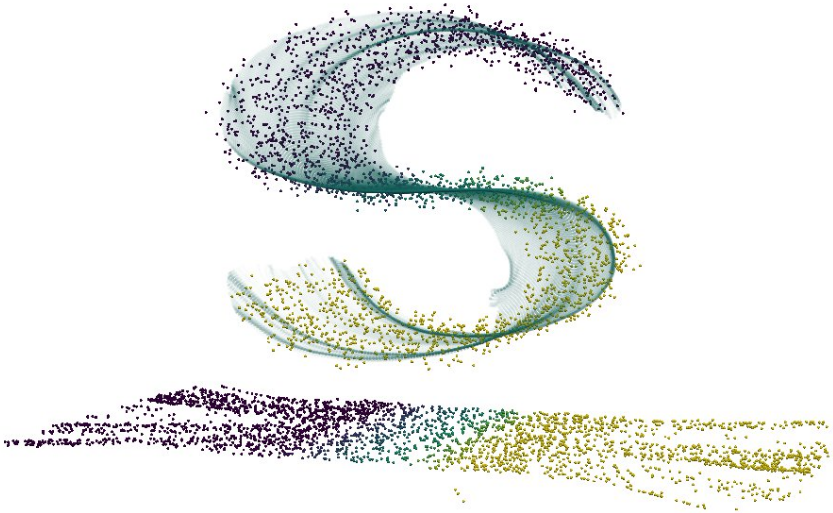
Top: noisy observations on the S-surface, embedded in
8.3.2 Towards a BCH Formula on the Diffeomorphism Group with a Right-invariant Metric
This work was funded by the ERC grant #786854 G-Statistics from the European Research Council under the European Union's Horizon 2020 research and innovation program.
Keywords:
Participants: James Benn [Correspondant], Stephen Marsland [Victoria Uni. of Wellington, New Zeland].
The Baker-Campbell-Hausdorff (BCH) formula links a Lie group with its Lie algebra by giving a formula for group multiplication of elements close to the identity in terms of the Lie bracket. This has many practical applications to geometry, algebra, and partial differential equations, and provides simple proofs of further developments of Lie theory. To date, there is no BCH formula for the diffeomorphism groups - infinite dimensional Lie groups which naturally arise in continuum mechanics and diffeomorphometry for medical imaging (such as Large Deformations Diffeomorphic Metric Mapping - LDDMM or Stationary Velocity Fields - SVF). In the paper "Towards a BCH Formula on the Diffemorphism Group with a Right-Invariant Metric" 59 we provide the relevant background in an expository manner, starting with finite dimensional Lie Groups, and take a first step towards developing a BCH formula for the exponential map of a right-invariant metric on a Lie Group
8.3.3 Graph Alignment Exploiting the Spatial Organization Improves the Similarity of Brain Networks
This work was funded by the ERC grant #786854 G-Statistics from the European Research Council under the European Union's Horizon 2020 research and innovation program.
Keywords:
Participants: Anna Calissano [Correspondant], Samuel Deslauriers-Gauthier, Theodore Papadopoulo, Xavier Pennec.
Can the structural and functional properties of a specific brain region of an atlas be assumed to be the same across subjects? We addressed this question by looking at the network representation of the brain, with nodes corresponding to brain regions and edges to their structural relationships 10. We perform graph matching on a set of control patients and on parcellations of different granularity to understand which is the connectivity misalignment between regions. The graph matching is unsupervised and reveals interesting insight on local misalignment of brain regions across subjects as shown in Figure 12.
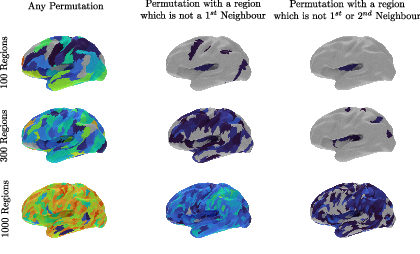
Surface visualization of the permutation type. For each region, we considered the rate at which a region was permuted with any other region (i.e. not a self permutation), with a region that is not a 1st degree neighbor, and with a region that is not a 1st or 2nd degree neighbor. Warmer and colder colors indicate a higher and lower permutation rates, respectively. Gray indicates no permutation. The three rows correspond to a brain parcellation with 100, 300, and 1000 regions.
8.3.4 Towards Barycentric Subspace Analysis for Graphs
This work was funded by the ERC grant Nr. 786854 G-Statistics from the European Research Council under the European Union's Horizon 2020 research and innovation program.
Keywords:
Participants: Anna Calissano [Correspondant], Elodie Maignant, Xavier Pennec.
Barycentric Subspaces have been defined in the context of manifolds using the notion of exponential barycenters. In this work, we extend the definition to quotient spaces which are not necessary manifolds. We define an alignment map and an horizontal logarithmic map to introduce Quotient Barycentric Subspaces (QBS). Due to the discrete group action and the quotient structure, the characterization of the subspaces and the estimation of the projection of a point onto the subspace is far from trivial. We propose two algorithms towards the estimation of the QBS and we discussed the results, underling the possible next steps for a robust estimation and their application to different data types 30.
8.3.5 Riemannian Geometry and Geometric Statistics: from Basic Theory to Implementation with Geomstats
This work was supported by the ERC grant #786854 G-Statistics from the European Research Council under the European Union's Horizon 2020 research and innovation program and by the French government through the 3IA Côte d'Azur Investments ANR-19-P3IA-0002 managed by the National Research Agency.
Keywords:
Participants: Nicolas Guigui, Xavier Pennec [Correspondant], Nina Miolane [Univ. California Santa Barbara, USA].
Riemannian geometry is a natural framework to model and unify complex nonlinear sources of data. However, the development of computational tools from the basic theory of Riemannian geometry is laborious. The work presented in 16 forms one of the main contributions to the open-source project geomstats, that consists in a Python package providing efficient implementations of the concepts of Riemannian geometry and geometric statistics, both for mathematicians and for applied scientists for whom most of the difficulties are hidden under high-level functions. The goal of this monograph is two-fold. First, we aim at giving a self-contained exposition of the basic concepts of Riemannian geometry, providing illustrations and examples at each step and adopting a computational point of view. The second goal is to demonstrate how these concepts are implemented in Geomstats, explaining the choices that were made and the conventions chosen. The general concepts are exposed and specific examples are detailed along the text. The culmination of this implementation is to be able to perform statistics and machine learning on manifolds, with as few lines of codes as in the wide-spread machine learning tool scikit-learn. We exemplify this with an introduction to geometric statistics (Figure 13).
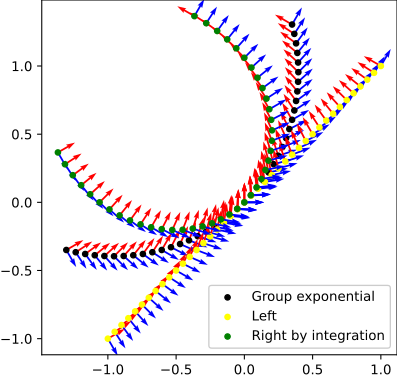
Visualization of geodesics and one-parameter subgroups on SE(2).
8.3.6 Geometry of Sample Spaces
This work was partly supported by the ERC grant #786854 G-Statistics from the European Research Council under the European Union's Horizon 2020 research and innovation program and by the French government through the 3IA Côte d'Azur Investments ANR-19-P3IA-0002 managed by the National Research Agency.
Keywords:
Participants: Philipp Harms [Nanyang Technological University, Singapour], Peter Michor [University of Vienna , Austria], Xavier Pennec [Correspondant], Stefan Sommer [Univ. Copenhagen, DK].
In statistics, independent, identically distributed random samples do not carry a natural ordering, and their statistics are typically invariant with respect to permutations of their order. Thus, an n-sample in a space M can be considered as an element of the quotient space of Mn modulo the permutation group. We take in 18 this definition of sample space and the related concept of orbit types as a starting point for developing a geometric perspective on statistics. We aim at deriving a general mathematical setting for studying the behavior of empirical and population means in spaces ranging from smooth Riemannian manifolds to general stratified spaces. We fully describe the orbifold and path-metric structure of the sample space when M is a manifold or path-metric space, respectively. These results are non-trivial even when M is Euclidean. We show that the infinite sample space exists in a Gromov-Hausdorff type sense and coincides with the Wasserstein space of probability distributions on M. We exhibit Fréchet means and k-means as metric projections onto 1-skeleta or k-skeleta in Wasserstein space, and we define a new and more general notion of polymeans. This geometric characterization via metric projections applies equally to sample and population means, and we use it to establish asymptotic properties of polymeans such as consistency and asymptotic normality.
8.3.7 Barycentric Subspaces for Geometric Learning
This work was funded by the ERC AdG G-Statistics (#786854) from the European Research Council under the European Union's Horizon 2020 research and innovation program.
Keywords:
Participants: Elodie Maignant [Correspondant], Xavier Pennec, Alain Trouvé [Centre Borelli, ENS Paris-Saclay], Anna Calissano.
In the PhD of Elodie Maigant 51, we explore further novel dimensionality reduction methods for the analysis of non-Euclidean data based on the notion of barycentric subspace. This includes more specifically:
- the generalization of Locally Linear Embedding (LLE) to non-Euclidean data 34 and the geometric characterization of such embedding;
- the construction of a new framework for statistical graph analysis as well as the implementation of barycentric susbpace analysis within this framework (Figure 14).
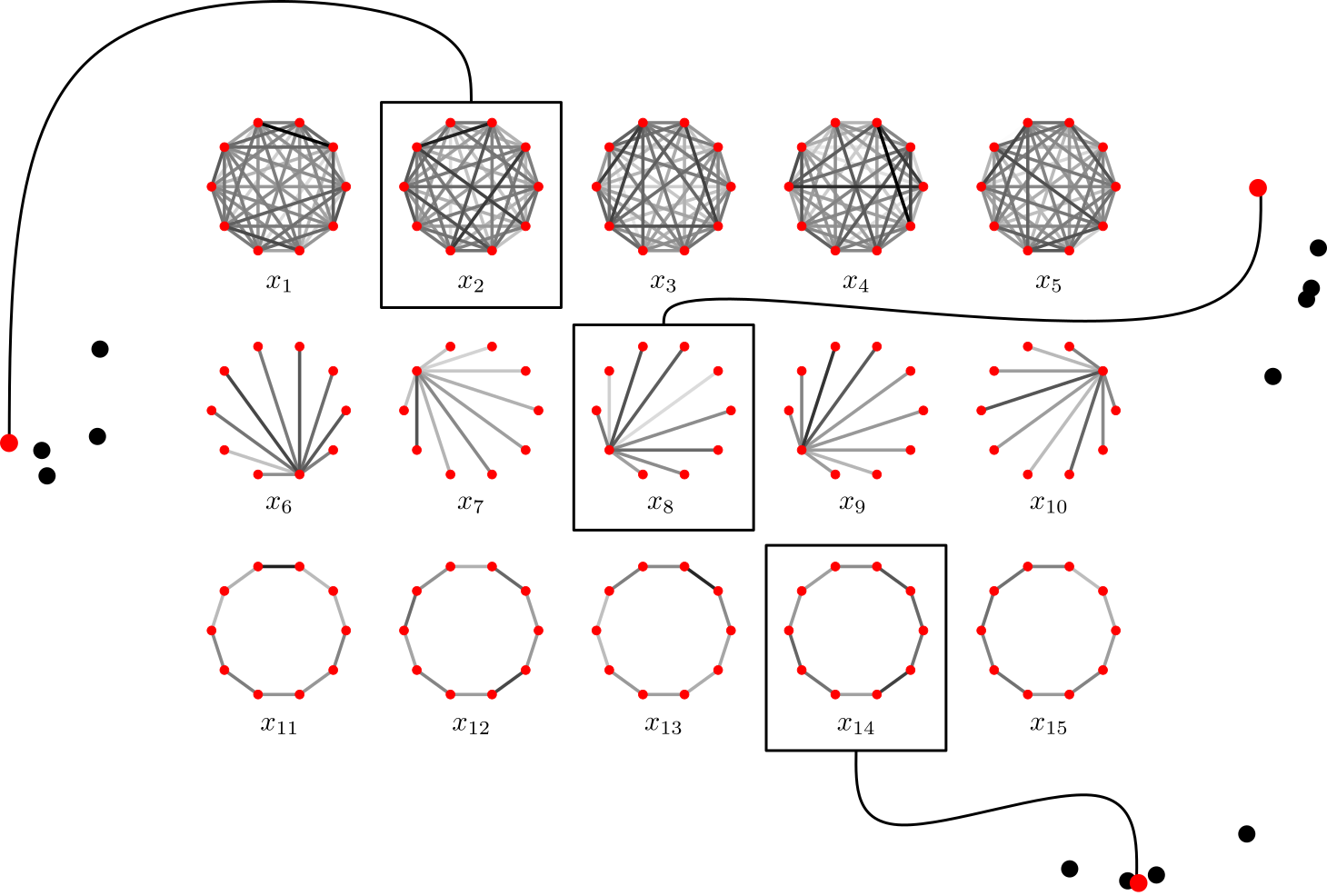
Barycentric subspace analysis of a set of graphs.
8.3.8 Riemannian Logarithm on Flag Manifolds
This work was supported by the ERC grant Nr. 786854 G-Statistics from the European Research Council under the European Union's Horizon 2020 research and innovation program and by the French government through the 3IA Côte d'Azur Investments ANR-19-P3IA-0002 managed by the National Research Agency.
Keywords:
Participants: Tom Szwagier [Correspondant], Xavier Pennec.
In 37, we propose an algorithm to approximate the Riemannian logarithm and geodesic distance on flag manifolds.
- We formulate their computation as an optimization problem on orthogonal matrices.
- We relax this problem and find an explicit solution related to Procrustes analysis.
- The associated iterative algorithm (cf. Figure 15) brings drastic improvements over the state-of-the-art and has been made available on GitHub.
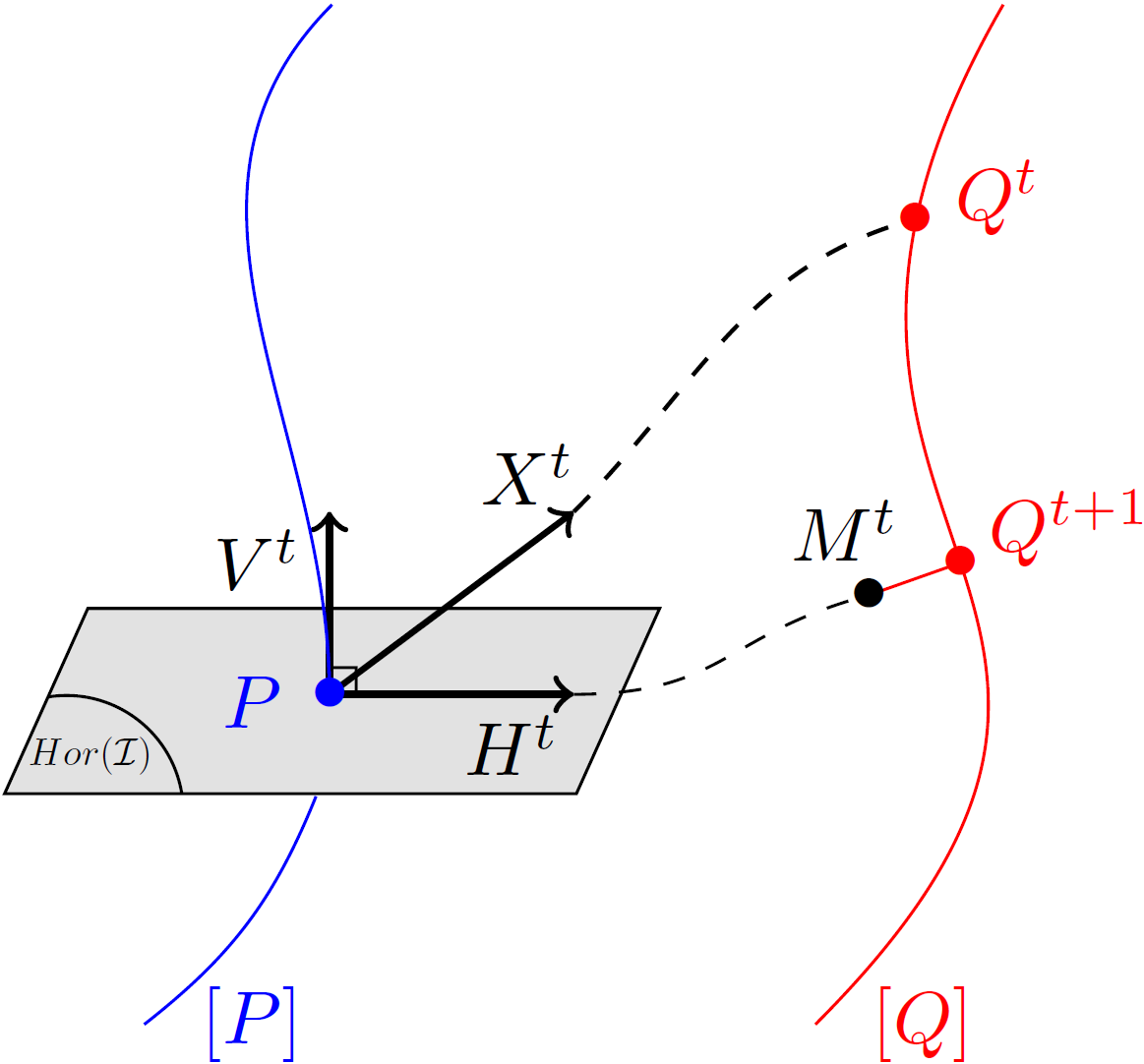
Illustration of the proposed alignment algorithm to approximate the Riemannian logarithm and geodesic distance on flag manifolds.
8.3.9 Riemannian and Stratified Geometries on Covariance and Correlation Matrices
This work was partly supported by the ERC grant #786854 G-Statistics from the European Research Council under the European Union's Horizon 2020 research and innovation program and by the French government through the 3IA Côte d'Azur Investments ANR-19-P3IA-0002 managed by the National Research Agency.
Keywords:
Participants: Yann Thanwerdas [correspondant], Xavier Pennec.
We investigated families of Riemannian and stratified geometries on covariance and correlation matrices. For SPD matrices, we characterized all the continuous metrics invariant by O(n) by means of three multivariate continuous functions, that encompass the classical metrics (log-Euclidean, Bogoliubov-Kubo-Mori - BKM, power-Euclidean) for which we detail all the basic Riemannian operations 25 (see Figure 16). A side result was the characterization of invariant inner products 38. On the space of full-rank correlation matrices, we showed that the curvature of the recently introduced quotient-affine metric is of non-constant sign and unbounded from above. We introduce computationally more convenient Hadamard or even log-Euclidean metrics, along with their geometric operations. To recover the lost invariance under permutations, we define two new permutation-invariant log-Euclidean metrics, one of them being invariant under a natural involution on full-rank correlation matrices. For positive semi-definite symmetric (PSD) matrices, we studied the stratified Riemannian structure of the Bures-Wasserstein distance. A notable contribution was the computation of the injection domain within each stratum and the characterization of the length-minimizing curves between the strata of different ranks 24.
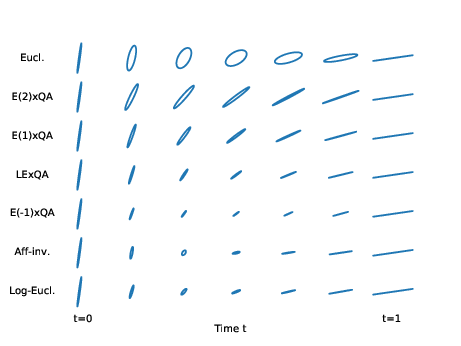
Interpolation between two SPD matrices with different Riemannian metrics.
8.4 Computational Cardiology & Image-Based Cardiac Interventions
8.4.1 Causal Data Analysis for Torsade de Pointes Risk Assessment
This work was supported by the European Union's Horizon 2020 Research and Innovation Program SimCardioTest project which has received funding from the European Union's Horizon 2020 research and innovation program under grant agreement No. 101016496.
Keywords:
Participants: Safaa Al-Ali [Correspondant], Irene Balelli, Maxime Sermesant, Jordi Llopis Lorente [Centro de Investigación e Innovación en Bioingeniería (Ci2B), Universitat Politecnica de Valencia, Valencia, Spain], Maria Teresa Mora [Ci2B], Beatriz Trenor [Ci2B].
- In 29, we employed the causal discovery method ICA-Linear Non-Gaussian Acyclic Model (ICA-LiNGAM) to uncover the relations across the 7 ion channels identified by the Comprehensive in vitro Pro-arrhythmia Assay (CiPA) initiative as potentially related to the induction of Torsade de Pointes (TdP) risk. We identified I_Kr , I_NaL and I_CaL as the ones that directly affect TdP-risk assessment, and suggested that I_Na perturbations could potentially impact on pro-arrhythmic risk induction (cf Figure 17 (1-3)). Furthermore, we independently performed binary drug risk classification and showed that the combination of the 3 selected ionic currents maximizes the classification accuracy outperforming state-of-the-art approaches based on alternative ion channel combinations.
- Each drug used in 29 has an associated known Effective Therapeutic Plasma Concentration (EFTPC), which denotes the concentration of the drug in the bloodstream required to produce the desired therapeutic effects. We simulated a variation of the drug plasma concentration, searching for a threshold above which each molecule turns out to be unsafe. We found that a concentration of approximately six times the EFTPC is sufficient to classify all intermediate classes' drugs as unsafe (Figure 17).
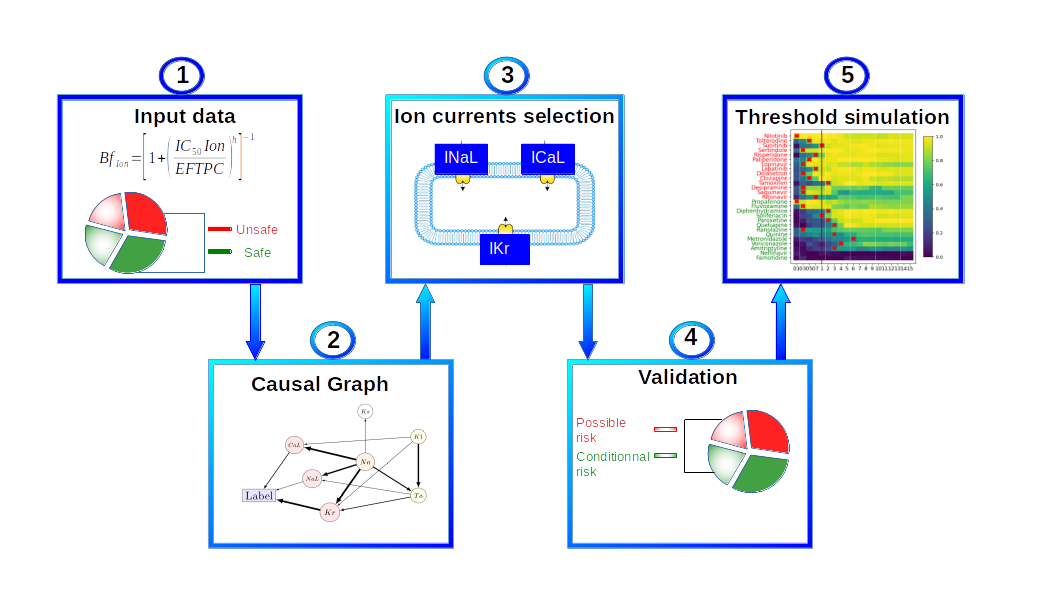
Pipeline of the proposed method inspired by 29. (1) Data preparation: computation of ionic currents blockade for class 1 and class 4 drugs. (2) Application of the ICA-LINGAM algorithm to define the causal cascade leading to the drug safety labelling, and (3) Selection of the most relevant ionic currents for proarrhythmic risk assessment. (4) Training of the binary classifier on classes 1 and 4 drugs, and validation on the intermediate risk classes i.e. class 2 and class 3 drugs, using the retained combination of ionic currents. (5) Simulation of the safety threshold for plasma drug concentration for each molecule in the intermediate risk classes.
8.4.2 Efficient Patient-Specific Simulations of Ventricular Tachycardia Based on Computed Tomography-defined Wall Thickness Heterogeneity
This work was funded by ANR-10-IAHU-04 "Investissements du futur".
Keywords:
Participants: Nicolas Cedilnik [Correspondant], Mihaela Pop, Maxime Sermesant.
- Foundational work has shown that acquiring heart-specific electrophysiological data allows model personalization able to simulate ischemic ventricular tachychardia re-entrant patterns.
- Later work has shown that CT-defined left ventricular wall thickness is correlated to electrophysiological properties and that this imaging feature is suitable for model personalization.
- Our latest work 11 pushes the concept further by reproducing the VT induction procedure using reaction-diffusion models parametrized on CT-defined wall thickness (Figure 18).
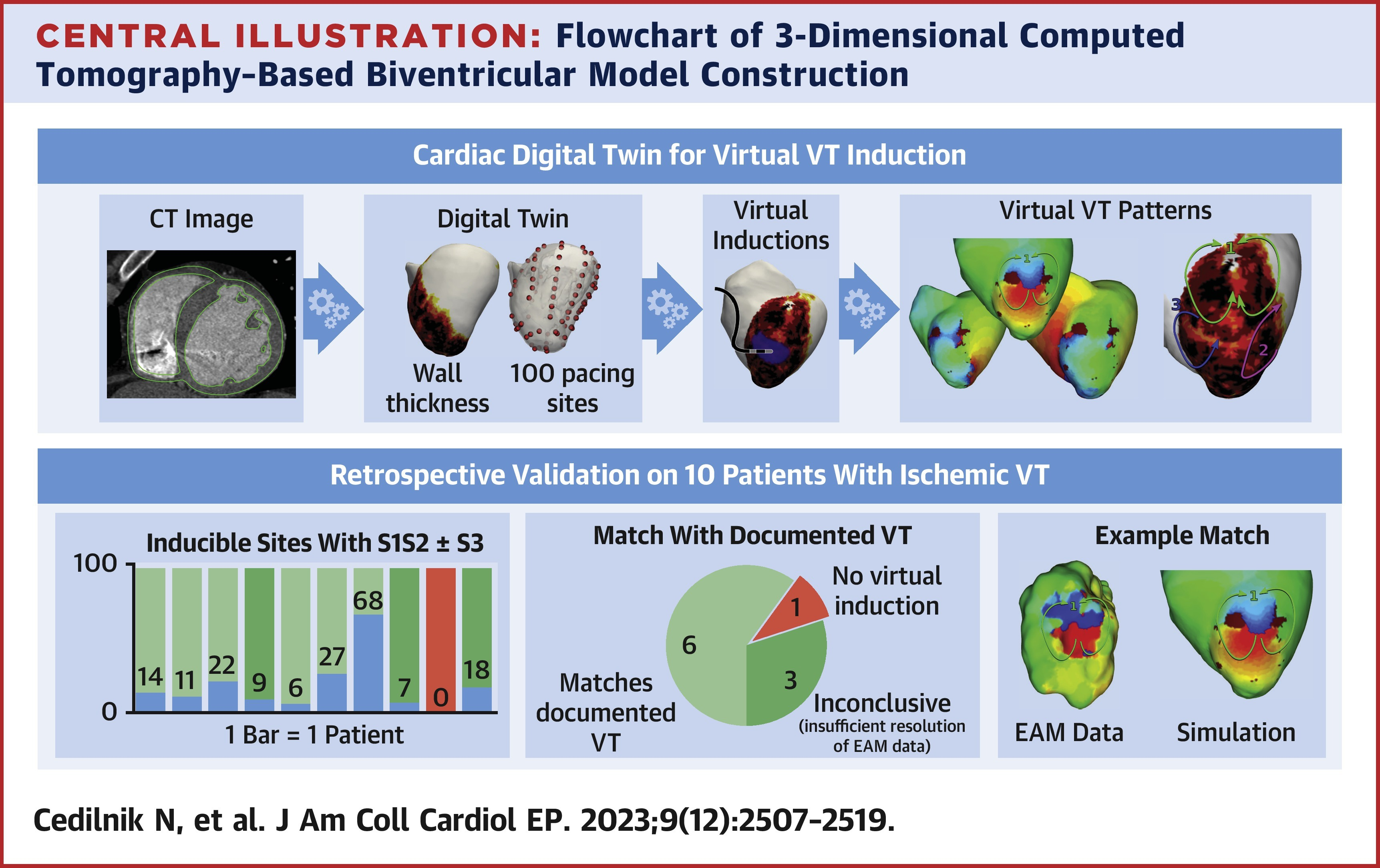
Flowchart of 3-Dimensional Computed Tomography–Based Biventricular Model Construction
8.4.3 Personalization of Cardiac Models for the Prediction of Cardiac Resynchronization Therapy Response
This work has been supported by the French government through the National Research Agency (ANR) Investments in the Future 3IA Côte d’Azur (ANR-19-P3IA-000) and by Microport CRM funding.
Keywords:
Participants: Gaëtan Desrues [Correspondant], Serge Cazeau [Microport CRM], Thierry Legay [Microport CRM], Delphine Feuerstein [Microport CRM], Maxime Sermesant.
Patient-specific 3D electromechanical models can help in improving patient selection, therapy optimization and interventional guidance. The aim of this project is to study the response to cardiac resynchronization therapy, with the help of personalized cardiac models, see Figure 19. The following work has been realized:
- Calibration of the active and passive mechanical properties of cardiac tissue,
- AI-based personalization of the electromechanical model using cardiac indices measured on both healthy and diseased patients,
- Predictions to CRT response through pacing simulations,
- Preparation and publication of the PhD manuscript of G. Desrues 46.

Global pipeline for patient-specific simulations and prediction to CRT response.
8.4.4 Cardiac Electrophysiology Model Correction Using Differentiable Physics and Deep Learning
This PhD has been funded by 3IA Côte d'Azur DeepNum project (ANR-21-CE23-0017)
Keywords:
Participants: Victoriya Kashtanova [Correspondant], Mihaela Pop, Maxime Sermesant, Ibrahim Ayed [LIP6, Paris], Patrick Gallinari [LIP6, Paris].
We present a fast hybrid approach to learn cardiac electrophysiology dynamics from data. Our novel framework has two components, decomposing the dynamics into a physics and a data-driven term (see Figure 20). We show experimentally in 20, 50 that this construction allows our framework to learn from data of different complexity, while simultaneously estimating model parameters. This physics-based data-driven approach may improve cardiac EP modeling by providing a robust biophysical tool for predictions.
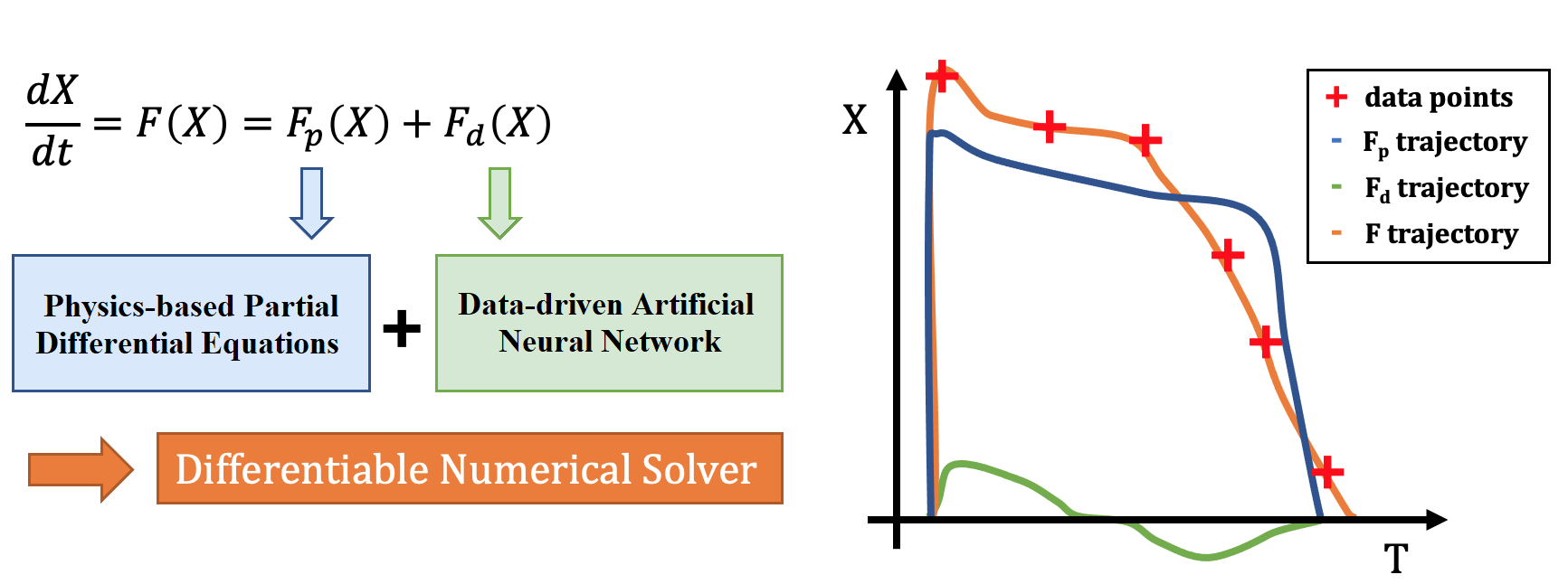
General APHYN-EP framework. Correction of a PDE-based model (
8.4.5 Outcome Prediction in Cardiology: a Practical Guide
Part of this work has been supported by the French Government, through the National Research Agency (ANR) 3IA Côte d'Azur (ANR-19-P3IA-0002), IHU Liryc (ANR- 10-IAHU-04), Université Côte d'Azur and Ecole Doctorale Sciences et Technologies de l'Information et de la Communication (EDSTIC).
Keywords:
Participants: Buntheng Ly [Correspondant], Mihaela Pop, Hubert Cochet, Nicolas Duchateau, Declan O'regan, Maxime Sermesant.
We contributed to the Outcome Prediction chapter, as part of the AI and Big Data Application in Cardiology: A Practical Guide textbook 45. The chapter covered the state-of-the-art methodologies in three clinical applications: cardiac resynchronization therapy (CRT) response, atrial fibrillation and ventricular arrhythmia (Figure 21).
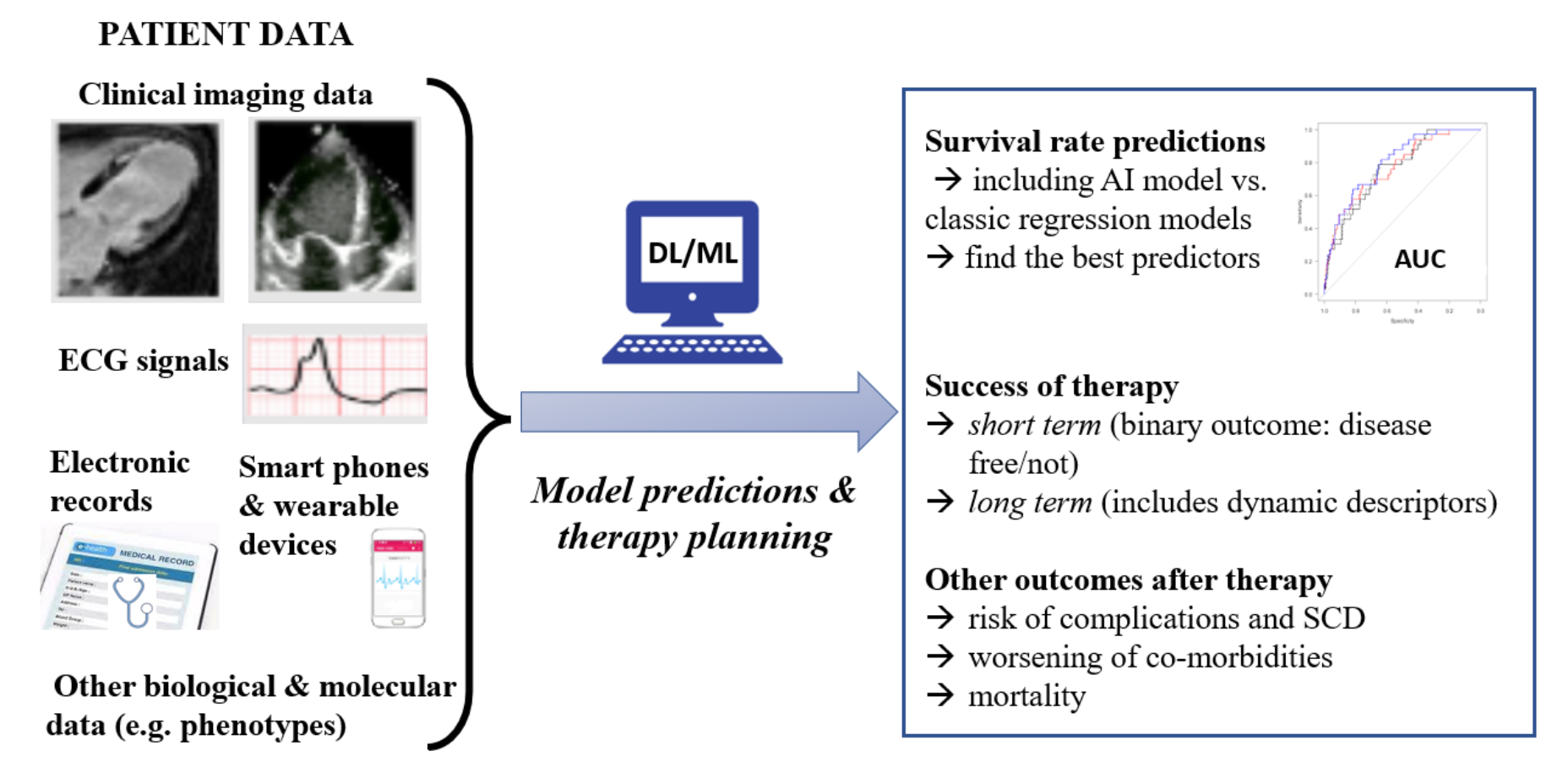
Example of a generic pipeline for building AI-based models to predict survival rate or therapy outcome for cardiac application.
8.4.6 Inducibility of Ventricular Tachycardia by Means of Different Stimulation Protocols: an Electrophysiology Simulation Study
This work has received funding from the European Union's Horizon 2020 research and innovation programme under grant agreement No 101016496 (SimCardioTest), and from the ANR's PEPR project ChroniCardio, contract number 2023000289.
Keywords:
Participants: Jesus Jairo Rodríguez Padilla [Correspondant], Buntheng Ly, Rafael Silva, Mihaela Pop, Maxime Sermesant.
In this work we propose to leverage on computer simulations to study the inducibility of ventricular tachycardia (VT) by replicating the stimulation protocols typically employed in the clinics, but testing different locations of the stimulus site. This will allow us to gain insight into the effect of stimulus location on the electrophysiologic response in the presence of scar tissue. Figure 22 shows the whole pipeline of our study as well as two simulation results showing different electrical behaviors depending on the pacing site location.
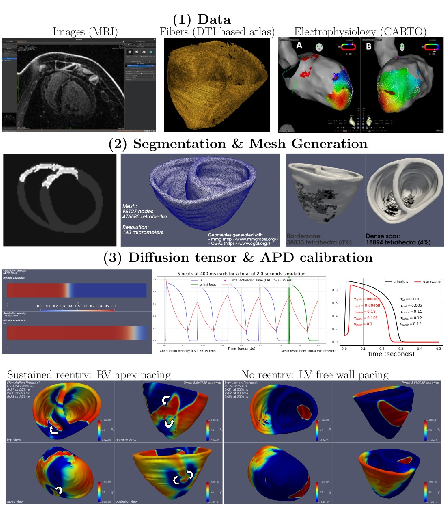
Pipeline process to generate realistic electrophysiological simulations: (1) MR images, cardiac structure (DTI-based atlas), electrophysiology (CARTO); (2) Segmentation and mesh generation; (3) Personalization and Calibration; Simulation results.
8.4.7 Unsupervised Polyaffine Transformation Learning for Echocardiography Motion Estimation
This work has been funded by 3IA Côte d'Azur (ANR-19-P3IA-0002) and Inria.
Keywords:
Participants: Yingyu Yang [Correspondant], Pamela Moceri, Marie Rocher, Maxime Sermesant.
The main contributions in this project include 39:
- the development of a novel polyaffine motion model (PAM) for unsupervised cardiac motion estimation;
- the design of a comprehensive pipeline for using PAM in a weakly-supervised manner on a large public echocardiography dataset (Figure 23);
- comprehensive experiments on various real-world datasets, showing that PAM outperforms other popular deep learning-based motion estimation methods and thereby highlighting its potential for clinical applications.
This work has been included in the PhD manuscript of Yingyu Yang 55.
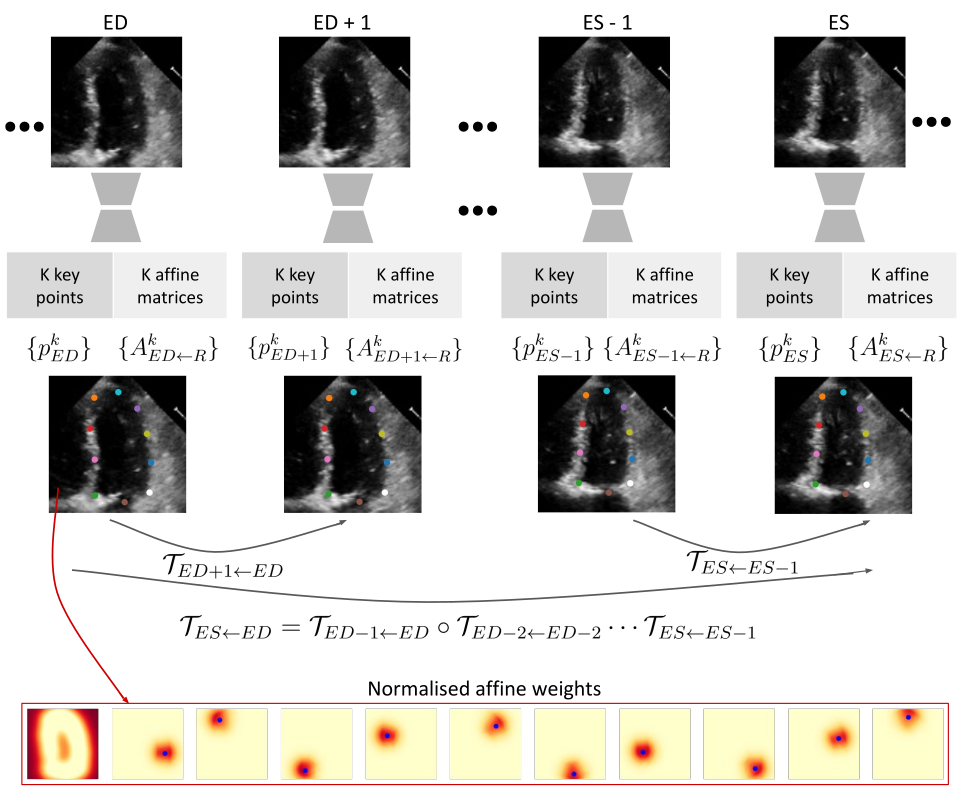
Method overview. Given a sequence of input images, an encoder-decoder network first extracts K key points and the corresponding local affine transformation. Second, by applying polyaffine motion fusion, the final dense motion field is obtained.
8.5 Multi-centric data and Federated Learning
8.5.1 Federated Missing Data Imputation: Towards Federated Pre-processing
This work was supported by the French government, through the 3IA Côte d’Azur Investments in the Future project managed by the National Research Agency (ANR) with the reference number ANR-19-P3IA-0002.
Keywords:
Participants: Irene Balelli [Correspondant], Aude Sportisse [Post Doc, MAASAI Team], Francesco Cremonesi, Pierre-Alexandre Mattei [CR, MAASAI Team], Marco Lorenzi.
Despite Federated Learning (FL) has shown great potential for cross-institutional medical research, a major bottleneck for its real-world deployment is how to carry out data pre-processing, form simple operations such as data standardization, up to the management of missing entries in the databases.
- We propose Fed-MIWAE 58, a federated version of the state-of-the-art imputation method MIWAE, a deep latent variable model for imputation of Missing At Random (MAR) data based on variational autoencoders.
- We evaluate our method on multi-modal medical imaging data and clinical scores from a simulated federated scenario with the ADNI dataset and on the Traumabase dataset, a multicentric cohort study dedicated to the management of polytrauma patients.
- We compare Fed-MIWAE with respect to classical imputation methods, either performed locally or in a centralized fashion (Fig. 24 (a)), achieving with Fed-MIWAE an imputation accuracy comparable with the centralized training, even when local data distributions are highly heterogeneous, and the local dataset size is small.
- The variational nature of Fed-MIWAE makes it naturally designed to perform multiple imputation (Fig. 24 (b)), allowing for the quantification of the imputation uncertainty in the federated scenario.
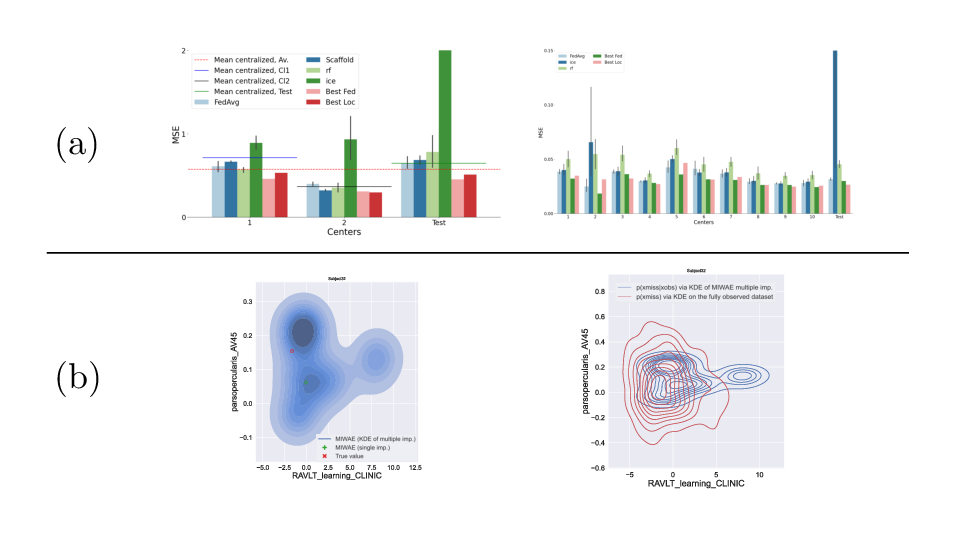
(a) Comparison of federated and local models on single imputation, in all local datasets and in the external one, measured through MSE, for the ADNI (left) and Traumabase (right) datasets. (b) An example of multiple imputation on one patient of the ADNI dataset. The left panel shows the corresponding comparisons between
8.5.2 Real-world Deployment of Federated Learning in Biomedical Research Consortia with Fed-BioMed
This project received financial support by the French government through the Agence Nationale de la Recherche (ANR), project Fed-BioMed ref. num. ANR-19-CE45-0006.
Keywords:
Participants: Francesco Cremonesi [Correspondant], Sergen Cansiz, Yannick Bouillard, Marc Vesin, Irene Balelli, Marco Lorenzi.
Fed-BioMed is an open-source initiative aimed at enabling real-world deployment of federated learning in biomedical research 63.
Fed-BioMed has been successfully deployed in hospital setting, and will be scaled out to larger federations in the coming year. In the first instance, three French hospitals from the UniCancer consortium (Centre Antoine Lacassagne, Centre Henri Becquerel, Institut Curie) have participated in the joint training of a prostate segmentation task using publicly available data. Fed-BioMed was deployed in all three hospitals under real-world conditions, and a successful training of the model was achieved leading to a performance comparable with a centralized approach, as shown in Figure 25. In the second instance, Fed-BioMed was deployed in two nodes of the EUCAIM project network, under real-world conditions, as part of the M9 demonstrator milestone, to achieve a proof-of-concept training of both a logistic regression and an image classification task using public data.
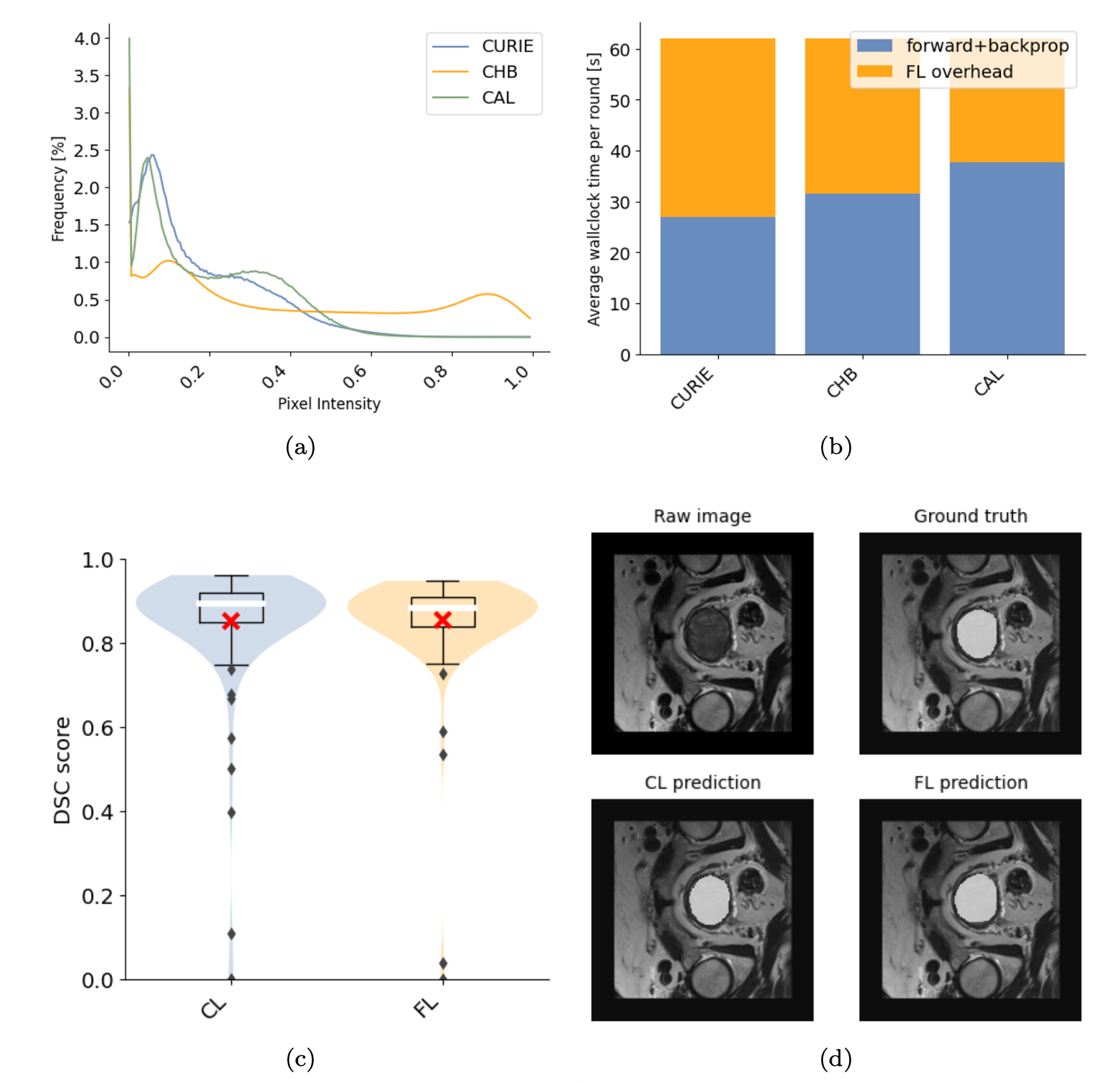
a) Pixel intensity distribution grouped by clinical site. b) Breakdown of FL experiment wallclock runtime. c) Distribution of Dice scores for centralized (CL) and federated (FL) models, combining all cross-validation folds. d) Clockwise from top left: an example raw image, the ground truth segmentation, the FL model prediction and the CL model prediction.
8.5.3 Reliability and Robustness of Federated Learning in Practical Applications
This work was supported by a CIFRE contract with Accenture.
Keywords:
Participants: Yann Fraboni [Correspondant], Richard Vidal [Accenture], Laetitia Kameni [Accenture], Sebastien Ourselin [King's College London], Marco Lorenzi.
Federated learning (FL) enables a set of participants to jointly learn a global model without sharing their data. To tackle the problem of Federated Optimization in heterogeneous and sensitive setting, we proposed the following contributions:
- We introduced a novel theoretical framework to account for asynchronous FedAvg, where the server creates a new global model whenever receiving a client's contribution 15.
- We develop IFU, a novel unlearning framework for FL, that can measure a client's contribution in a trained model and unlearn it upon request with statistical guarantees 64.
- In collaboration with King's College London, Federated Unlearning with IFU was demonstrated on a real worl use-case for federated learning of a medical image segmentation model in prostate cancer analysis 33 (Figure 26).
- The ensemble of contributions were presented in the doctoral dissertation 47.
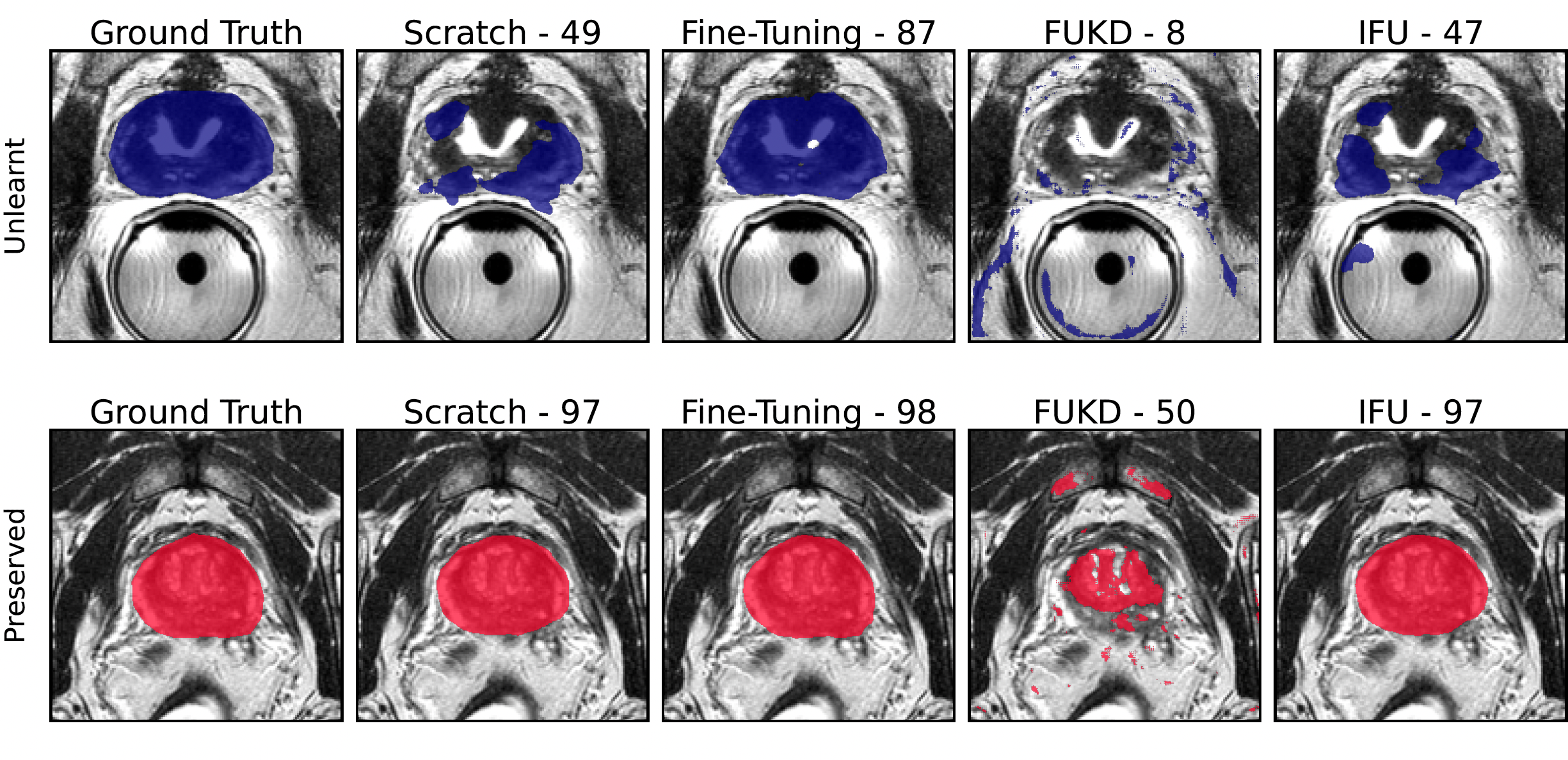
IFU Correctly unlearns a given data instance while guaranteeing accuracy on the remaining training data. Top: on the data to be unlearnt, the segmentation quality is equivalent to the one of a model trained from scratch without that data. Bottom: on data to be retained, the segmentation remains of good quality, at par with the model trained from scratch. We note that IFU outperforms the competing methods.
8.5.4 Multi-centric AI-based Framework for Prostate Cancer Patients Management on Active Surveillance Through Robust Federated Learning
This work has been funded by 3IA Côte d'Azur.
Keywords:
Participants: Lucia Innocenti [Correspondant], Marco Lorenzi, Michela Antonelli, Sebastien Ourselin.
Collaborative learning (CL) in healthcare is essential to address data governance-related challenges. Indeed, CL is emerging as a potent strategy for exploiting collective expertise and data resources from a federation of clients without the need to share data or sensitive information.
Our study 43 provides a comprehensive examination of CL methods, by benchmarking them in terms of performance and cost-effectiveness for a specific case study: multi-center prostate segmentation from 3D MRIs (Figure 27).
- We compared two CL approaches: Federated Learning (FL) and Consensus-Based Methods (CBM).
- In this specific scenario, CBM and FL are comparable in terms of performance.
- At the same time, CBM is more cost-effective, requiring fewer resources to be trained and naturally addressing some FL open problems like client dropout.
These insights will benefit researchers and practitioners seeking to optimize collaborative learning in healthcare, improving patient care and data security.
.png)
The table on top shows the comparison of the 5-fold DSC obtained in the segmentation task by different training strategies. The table in the middle shows the cost comparison of different training strategies, in terms of training and inference time and communication bandwidth. On the bottom, a representation of the segmentation task on a sample image using different strategies. In white, the ground truth; in red, the segmentation provided by each training approach.
8.5.5 StratifyAging: Interoperatibility of Clinical Studies and Routine Care for the Advent of a Stratified Medicine of Aging Using Clinical, Imaging, and Omics Data
This project received financial support by the PEPR Santé Numerique.
Keywords:
Participants: Ghiles Reguig [Correspondant], Marco Lorenzi.
The aim of this project is in the development of robust analysis tools for neuroimaging data, that can find application in multi-centric studies such as the French CATI. We are currently focusing on:
- Automatically harmonize and standardize data from various french centers using CATI (Centre d'Acquisition et de Traitement d'Images pour la maladie d'Alzheimer) data.
- Develop decentralized algorithms (using federated learning and the Fed-BioMed package) to conduct data analysis/hypothesis testing using different types of data (MRI, omics), as shown in Figure 28.
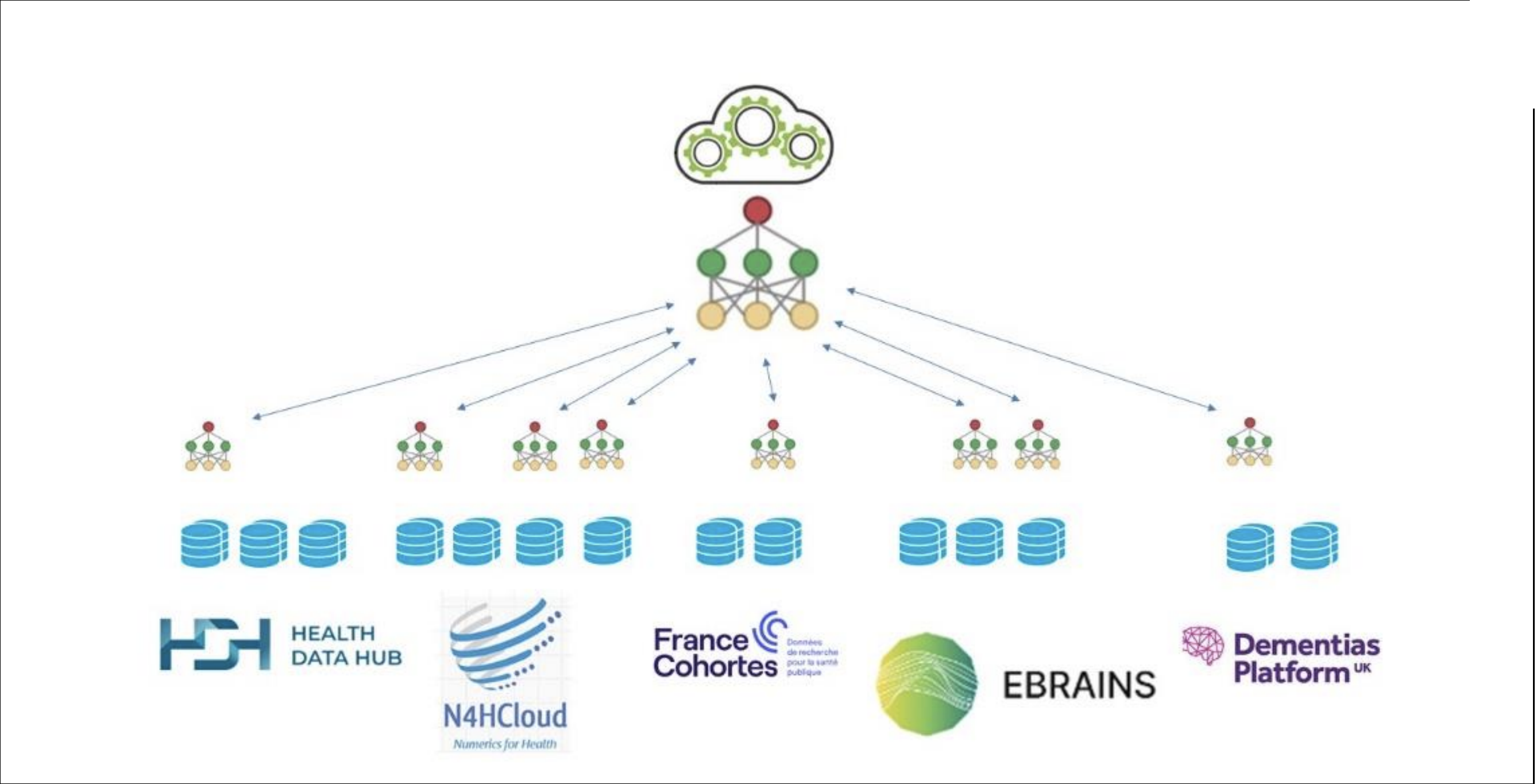
The federated framework that will be organized by StratifyAging in the long run. Several cloud-based platforms will host the datasets of interest. Data-driven harmonization procedures or stratification algorithms can be triggered on a selection of datasets using a federated strategy. The exact set of platforms will be defined in agreement with the sponsors and the PIs of the studies.
8.5.6 Federated Data Harmonization in Biomedical Research Using Mixed Effects Models: a Focus on Conditional Variational Autoencoders
This work has been funded by H2020/Marie Sklodowska-Curie Actions COFUND number 847579.
Keywords:
Participants: Santiago Silva [Correspondant], Marco Lorenzi.
Bias correction through harmonization is a crucial step in multicentric neuroimaging studies, as bias is introduced from sources like acquisition protocols and varied scanner types. In addition, with the introduction of data privacy regulations, data preprocessing steps require to be adapted to respect data governance. Traditional harmonization methods such as surrogate variable analysis and ComBat, limited by their inability to capture nonlinearities, and also conflict with data privacy laws due to their centralized data reliance. Federated learning (FL) can be used as a solution, enhancing data governance and compliance with privacy regulations. To tackle this problem we focused on the following actions:
- We introduced a harmonization approach based on a FL paradigm and conditional variational autoencoders (CVAEs) for decentralized data harmonization, addressing the aforementioned limitations and managing nonlinear relationships. The CVAE proposed acts as a mixed effects model whose random effects capture the multicentric biases (Figure 29).
- We presented preliminary findings on synthetic data and outline plans for extending our methodology to imaging applications, highlighting the potential and challenges in this innovative approach.
- The ensemble of contributions were defended in the doctoral dissertation 53.
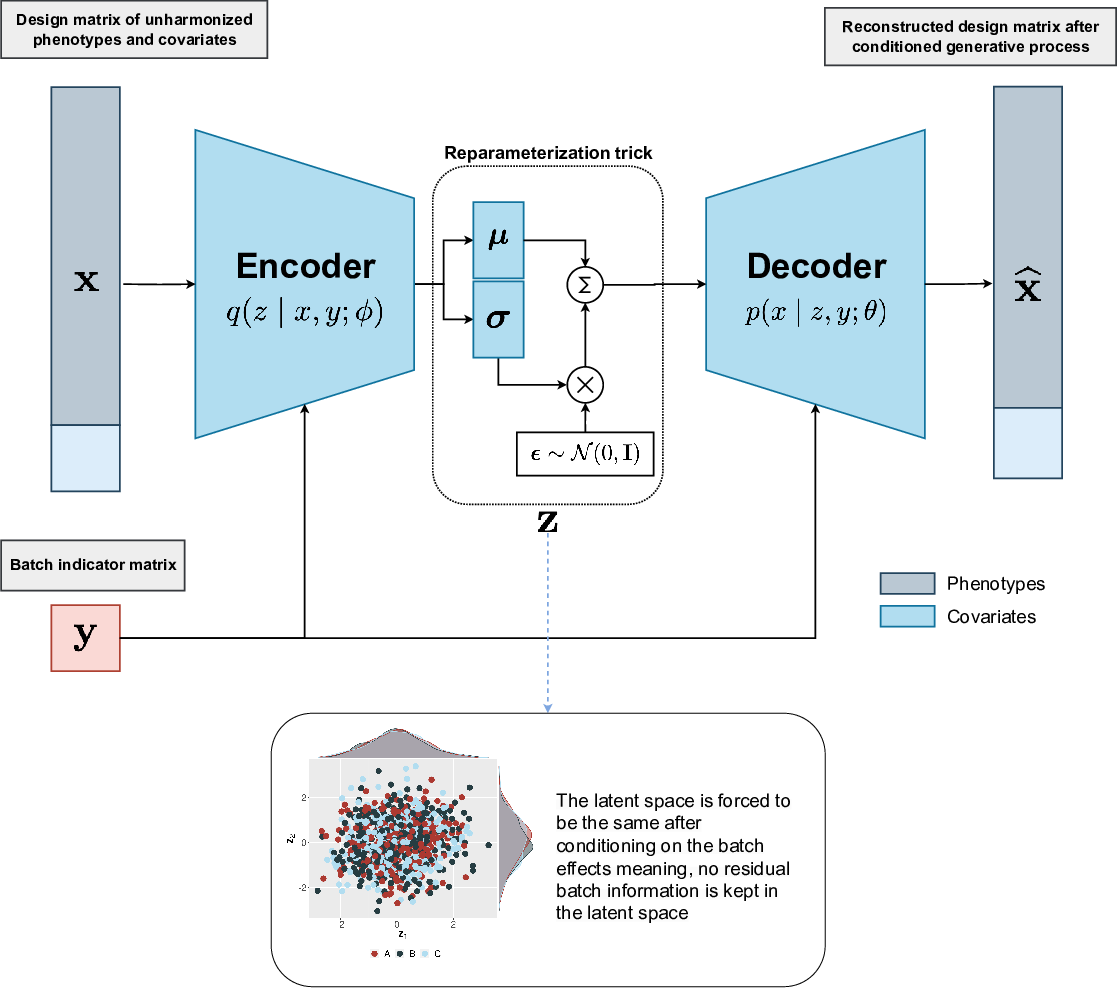
Architecture of the Conditional Variational Autoencoder (CVAE) for data harmonization. The input data
8.5.7 Data Structuration and Security in Large-scale Collaborative Healthcare Data Analysis
This work has been supported by the French government, through the 3IA Côte d'Azur Investments.
Keywords:
Participants: Riccardo Taiello [Correspondant], Marco Lorenzi, Melek Önen, Olivier Humbert.
Our work aims to study the impact of privacy-preserving methods in Federated Learning for biomedical applications:
- We extended Privacy Preserving Image Registration, with new cost function Figure 30;
- We proposed a new cryptographic protocol for Secure Aggregation in Federated Learning, tackling the problem of drop-out clients;
- We implemented Secure Aggregation scheme for Federated Learning in Fed-BioMed 63.
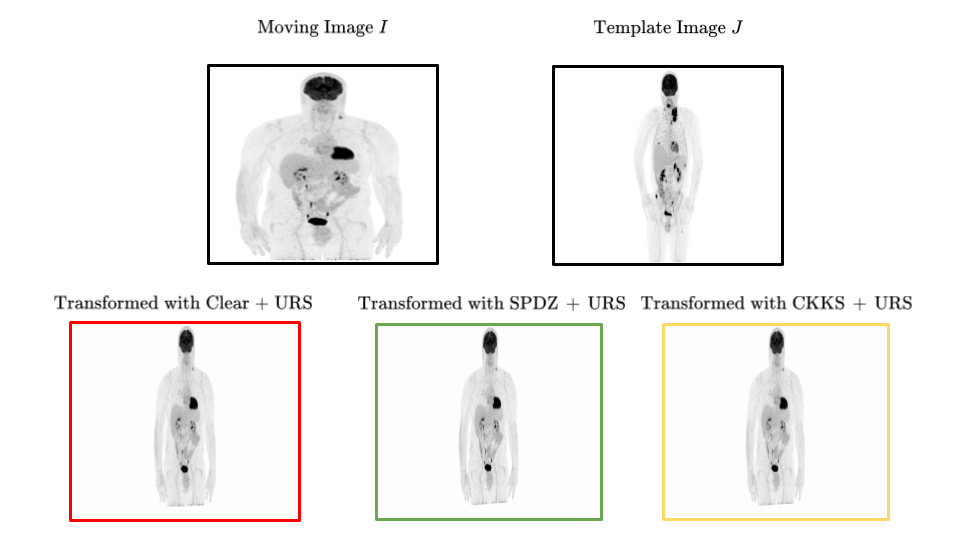
Privacy Preserving Image Registration. The red frame is the transformed moving image using the classic image registration. Green and Yellow frames are the transformed images using two different privacy-preserving tools.
8.5.8 Federated Unlearning
This project received financial support by the INRIA Defi Fed-Malin.
Keywords:
Participants: Martin Van Waerebeke [Correspondant], Marco Lorenzi, Kevin Scaman [Inria DYOGENE], Giovanni Neglia [Inria NEO].
This project studies the problem of machine unlearning, where we aim at removing the effect of a given data instance from a trained model, to guarantee the “right to be forgotten” in AI systems. Our contributions are the following:
- By using previous results on the contractivity of gradient descent under certain assumptions, we lowered the strength of the assumptions required to prove the main theorem of the paper. We also derived new bounds for an even larger assumptions set.
- To demonstrate the practical effectiveness of our algorithm, we conducted a series of new experiments. They were used to prove the empirical validity of some assumptions made in the paper. They also showcased that our results outperform competing methods when acting under time constraint for unlearning, as can be observed in Figure 31.
- A core aspect of this research was undertaking a comprehensive review of the field. This involved comparing the working assumptions and methodologies of different approaches within the domain. It allowed us to showcase the small amount of methods involving both realistic assumptions and theoretical guarantees in the federated unlearning setup.
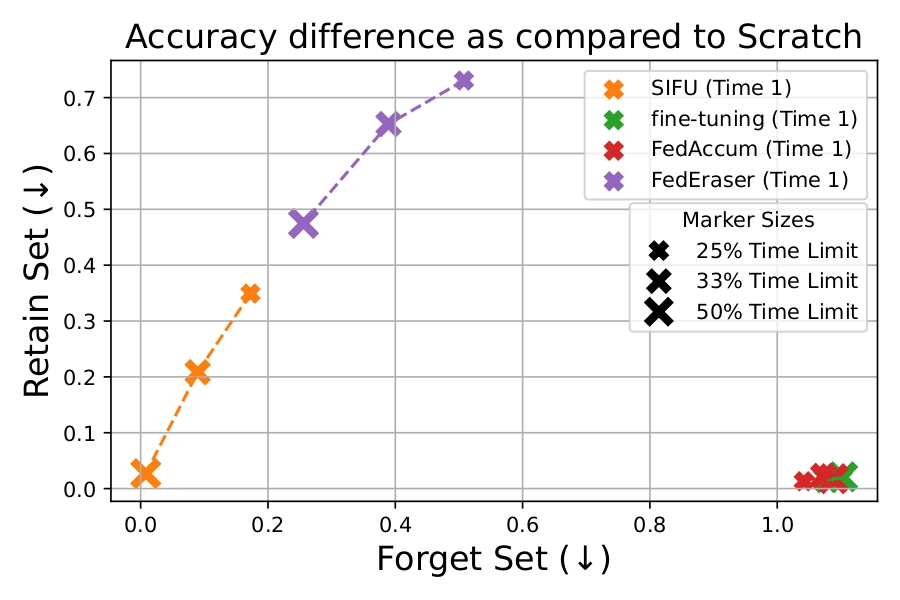
Comparing retain set and forget set accuracies after unlearning for a limited amounf of time on CIFAR100 for several methods in the field.
9 Bilateral contracts and grants with industry
9.1 Bilateral contracts with industry
9.1.1 Koelis
Participants: Nicholas Ayache, Hervé Delingette.
The company Koelis participates in the thesis work of Zhijie Fang and Manasi Kattel on the multimodal registration of MR and ultrasound images. The objective is to improve the accuracy of the targeted biopsies inside the prostate.
9.1.2 Accenture Labs
Participants: Marco Lorenzi, Yann Fraboni.
Accenture Labs, Sophia Antipolis, France, has funded the CIFRE PhD work of Yann Fraboni, which aims at investigating the problem of bias and fairness in federated learning applications. Accenture also supports the development of the platform Fed-BioMed.
9.1.3 MyDataModels
Participants: Marco Lorenzi.
MyDataModels, Sophia Antipolis, France, collaborates with Epione within the context of the postdoctoral project of Ghiles Reguig, aiming at developing a federated platform for the analysis of medical records in a network of hospitals in France.
9.1.4 Microport CRM
Participants: Maxime Sermesant, Gaëtan Desrues.
Microport CRM is a cardiac impantable device company, and has funded the PhD work of Gaëtan Desrues, which aims at using cardiac electromechanical modeling for cardiac resynchronization therapy planning.
9.1.5 ExactCure
Participants: Irene Balelli, Maxime Sermesant, Erwan Gaymard.
ExactCure, Nice, France, has funded the CIFRE PhD work of Erwan Gaymard, which aimed at the development of novel methods for meta-modeling in pharmacometrics, to allow the co-integration of highly heterogeneous sources. This PhD was interrupted.
9.1.6 Spin-off company inHEART
Participants: Maxime Sermesant.
inHEART is a spin-off of the Epione team and IHU Liryc funded in 2017. inHEART provides a service to generate detailed anatomical and structural meshes from medical images, that can be used during ablation interventions. inHEART received 2 awards, one from Aquitaine region and one i-LAB from the BPI. It raised 3.2 million euros in 2020. It currently employs 27 people. It is FDA and CE certified.
10 Partnerships and cooperations
10.1 International collaborations
-
Laboratory of Physics of Fluids, University of Twente, NL
Hervé Delingette is collaborating with Assistant Professor Guillaume Lajoinie, on the topics of Deep Learning for ultrasound imaging in the framework of the BoostUrCareer Cofund program and the thesis of Hari Sreedhar.
-
King's College London (KCL), London, UK
Marco Lorenzi is a collaborator of the School of Biomedical Engineering & Imaging Sciences at King's College London. This collaboration focuses on the development of novel collaborative learning methods to improve prostate cancer detection in multicentric studies.
-
University College London (UCL), London, UK
Marco Lorenzi is a collaborator of the COMputational Biology in Imaging and geNEtics (COMBINE) group within the Centre for Medical Image Computing (CMIC) of UCL. His collaboration is on the topic of spatio-temporal analysis of medical images and imaging-genetics, with special focus on brain imaging analysis and biomarker development.
-
Laboratory of Neuroimaging of Aging (LANVIE), Faculty of Medicine, Geneva University Hospitals, HUG
Marco Lorenzi collaborates with the LANVIE laboratory led by Prof. Giovanni B. Frisoni. The collaboration consists in developing and translating novel approaches for disease progression modeling in neurodegenerative disorders, such as Alzheimer's disease.
-
Illinois Institute of Technology (IIT, IL, USA)
Marco Lorenzi is currently a collaborator of IIT for the investigation of the complex relationship between brain atrophy and genetics in Alzheimer's disease, in particular for demonstrating the effectiveness of multivariate statistical models in providing a meaningful description of the relationship between genotype and brain phenotype.
-
Department of Computer Science, University of Copenhagen, DK
Xavier Pennec is collaborating with Pr. Stefan Sommer on stochastic and sub-Riemannian approaches to statistics, in the framework of his ERC G-statistics. They jointly advised the PhD thesis of Morten Akhoj Pedersen.
10.1.1 Participation in other International Programs
Project MDPARK, funded by Michael J. Fox Fundation
Participants: Marco Lorenzi.
-
Title:
Multimodal Dynamic Modeling and Prediction of Parkinsonian Symptom Progression
-
Partner Institution(s):
- Illinois Institute of Technology, USA
- Amsterdam University Medical Center, The Netherlands
- University of Southern California, USA
- Northwestern University School of Medicine, USA
-
Date/Duration:
2022-2026
-
Additionnal info/keywords:
Connectomics, Disease models, Network analysis, Neuroimaging
10.2 International research visitors
10.2.1 Visits of international scientists
Hervé Lombaert
-
Status
Associate Professor of Computer Engineering
-
Institution of origin:
ETS Montreal
-
Country:
Canada
-
Dates:
Jan-Feb 2023; Nov-Dec 2023
-
Context of the visit:
Collaboration with ETS Montreal, Canada
-
Mobility program/type of mobility:
Research stay
10.3 European initiatives
10.3.1 Horizon Europe
EUCAIM
Participants: Marco Lorenzi.
- Title:
-
Type:
H2020
-
Program:
Research and Inoovation
-
Duration:
2023-2027
-
Inria contact:
Marco Lorenzi
-
Coordinator:
University of Valencia, EIBR
-
Summary:
EUropean Federation for CAncer IMages (EUCAIM) is the cornerstone of the European Commission-initiated European Cancer Imaging Initiative, a flagship of Europe’s Beating Cancer Plan (EBCP), which aims to foster innovation and deployment of digital technologies in cancer treatment and care to achieve more precise and faster clinical decision making, diagnostics, treatment and predictive medicine for cancer patients.
EUCAIM will establish and deploy a pan-European digital federated infrastructure of FAIR pan-cancer anonymized images from Real-World Data, preserving the data sovereignty of providers. Furthermore, it will provide an Experimentation Platform for the development and benchmarking of AI tools toward Precision Medicine in cancer diagnosis and treatment. EUCAIM will address the fragmentation of the existing cancer image repositories by building a distributed atlas of cancer images, including both common and rare types of cancer, from existing initiatives, including related Research Infrastructures’ networks and successful Horizon 2020 projects. EUCAIM will target clinicians, researchers, and innovators, providing the means to build reproducible clinical decision-making systems supporting diagnosis, treatment, and predictive medicine. This Infrastructure will benefit citizens through improved healthcare procedures, and will stimulate the European market through the innovation of new tools and services.
10.3.2 H2020 projects
ERC G-Statistics
Participants: Xavier Pennec.
-
Title:
Geometric Statistics
-
Type:
ERC
-
Program:
H2020
-
Duration:
2018-2024
-
Inria contact:
Xavier Pennec
-
Coordinator:
Inria
-
Summary:
G-Statistics aims at exploring the foundations of statistics on non-linear spaces with applications in the Life Siences. Invariance under gauge transformation groups provides the natural structure explaining the laws of physics. In life sciences, new mathematical tools are needed to estimate approximate invariance and establish general but approximate laws. Rephrasing Poincaré: a geometry cannot be more true than another, it may just be more convenient, and statisticians must find the most convenient one for their data. At the crossing of geometry and statistics, G-Statistics aims at grounding the mathematical foundations of geometric statistics and to exemplify their impact on selected applications in the life sciences. So far, mainly Riemannian manifolds and negatively curved metric spaces have been studied. Other geometric structures like quotient spaces, stratified spaces or affine connection spaces naturally arise in applications. G-Statistics will explore ways to unify statistical estimation theories, explaining how the statistical estimations diverges from the Euclidean case in the presence of curvature, singularities, stratification. Beyond classical manifolds, particular emphasis will be put on flags of subspaces in manifolds as they appear to be natural mathematical object to encode hierarchically embedded approximation spaces. In order to establish geometric statistics as an effective discipline, G-Statistics will propose new mathematical structures and characterizations of their properties. It will also implement novel generic algorithms and illustrate the impact of some of their efficient specializations on selected applications in life sciences. Surveying the manifolds of anatomical shapes and forecasting their evolution from databases of medical images is a key problem in computational anatomy requiring dimension reduction in non-linear spaces and Lie groups. By inventing radically new principled estimations methods, we aim at illustrating the power of the methodology and strengthening the “unreasonable effectiveness of mathematics” for life sciences.
SimCardioTest
Participants: Maxime Sermesant, Irene Balelli, Jairo Rodriguez, Safaa Al Ali.
-
Title:
Simulation of Cardiac Devices & Drugs for in-silico Testing and Certification
- Link:
-
Duration:
From January 1, 2021 to December 31, 2024
-
Partners:
- Universidad Pompeu Fabra (UPF), Spain
- Institut national de recherche en informatique et en automatique (Inria), France
- Virtual Physiological Human Institute for Integrative Biomedical Research VZW (VPH Institute), Belgium
- Sorin CRM SAS (LIVANOVA), France
- EXACTCURE, France
- Simula Research Laboratory AS, Norway
- INSILICOTRIALS Technologies BV, Netherlands
- Université de Bordeaux (UBx), France
- Boston Scientific Scimed INC, United States
- Universitat Politècnica de València (UPV), Spain
- INSILICOTRIALS Technologies S.P.A. (InSilicoTrials), Italy
-
Inria contact:
Maxime Sermesant
-
Coordinator:
Inria
-
Summary:
Despite massive investment in healthcare, huge R&D cost increase and regulatory pathway complexity hamper tremendously commercialization of new devices & medicines, putting patient populations at risk of not receiving adequate therapy. At the same time, outside healthcare, computer modeling and simulation (CM&S) is precisely recognized to increase speed & agility while reducing costs of development. CM&S can create scientific evidence based on controlled investigations including variability, uncertainty quantification, and satisfying demands for safety, efficacy & improved access.
Cardiac modeling has dramatically gained maturity over the last decades, with personalization to clinical data enabling validation. We selected a number of cardiac devices and medicines where CM&S is mature enough and that represent the most common cardiac pathologies, to demonstrate a standardized and rigorous approach for in-silico clinical trials.
SimCardioTest will bring a disruptive innovation by creating an integrated and secure platform standardizing & bridging model simulations, in-silico trials, and certification support. This environment will go beyond the state-of-the-art in computational multi-physics & multi-scale personalized cardiac models. Diseased conditions and gender/age differences will be considered to overcome clinical trials limitations such as under-representation of groups (e.g. women, children, low socio-economic status). Advanced big data, visual analytics & artificial intelligence tools will extract the most relevant information.
It is critical that Europe demonstrates its capacity to leverage in-silico technology in order to be competitive in healthcare innovation. SimCardioTest exploitation aims at delivering a major economic impact on the European pharmaceutical and cardiac devices industry. It will accelerate development, certification and commercialization, and will produce a strong societal impact contributing to personalized healthcare.
inEurHeart
Participants: Maxime Sermesant.
-
Title:
inEurHeart: AI, Digital Twin & Clinical Trial for a Disruption in Catheter Ablation
- Link:
-
Duration:
2022 - 2024
-
Partners:
- Institut national de recherche en Informatique et Automatique (Inria), France
- Rotterdam University, Netherlands
- Inserm, France
- CHU Bordeaux, France
- inHEART, France
- Université de Bordeaux (UBx), France
-
Inria contact:
Maxime Sermesant
-
Coordinator:
Inria
-
Summary:
inEurHeart is an innovation project in Artificial Intelligence, Digital Twin & a Clinical Trial for a Disruption in Catheter Ablation for Ventricular Tachycardia, making ablation therapy accessible to most patients. This project is a collaborative project between 5 organizations in France and Netherlands funded by EIT Health – the European Institute of Innovation and Technology, co-funded by the European Union. This project will exemplify how the academic-industrial relationships can be fostered and can lead to drastic changes in clinical practice. EIT Health provides a unique opportunity to transfer Artificial Intelligence tools to enable the scale-up phase, and to validate the technology through a randomized clinical trial.
10.3.3 Other european programs/initiatives
TRAIN
Participants: Marco Lorenzi.
-
Title:
Trustworthy and Robust Artificial INtelligence
-
Type:
German-French joint call for proposals on Artificial Intelligence
-
Duration:
2023-2027
-
Inria contact:
Marco Lorenzi
-
Coordinator:
Inria
-
Summary:
The goal of TRAIN is to explore two main barriers to the widespread deployment of AI: the lack of trustworthiness and the lack of robustness. TRAIN, comprising of Inria and EURECOM from France and RUB and Fraunhofer IPT from Germany, will design, develop and evaluate new AI solutions that address these two challenges. The development of such AI systems requires careful attention at every aspect of the model development pipeline, starting from construction and training of models all the way to evaluation and deployment. The proposed research agenda focuses on the more challenging federated learning (FL) setting as a key paradigm to enable trustworthiness in the training phase. We also investigate trustworthiness and robustness of the evaluation and deployment phase in both centralized and collaborative machine learning. The project identifies four main objectives: (i) robust learning with data heterogeneity and bias; (ii) quantifying robustness with automated frameworks; (iii) privacy-preserving federated learning; (iv) adversarial robustness. TRAIN solutions will be integrated into real-world frameworks in two main application domains: healthcare and smart industry.
10.4 National initiatives
10.4.1 PEPR Digital Health ChroniCardio
Participants: Jairo Rodriguez, Mihaela Pop, Maxime Sermesant.
-
Duration:
2023 - 2027
-
Partners:
- Inria
- Hospices Civils de Lyon
- Assistance Publique - Hôpitaux de Marseille
- CREATIS
-
Inria contact:
Maxime Sermesant
-
Coordinator:
Inria
-
Summary:
ChroniCardio is a new 4-year multi-institution project funded by the French Research Priority Programme on Digital Health to accelerate the integration of multi-scale data (clinical, imaging, genetic, ECG, etc.) and the development of advanced modeling tools to predict the long-term evolution of non-ischemic dilated and hypertrophic cardiomyopathies. This includes the risk of arrhythmia, heart failure and sudden cardiac death. Our consortium brings together research scientists and engineers from Inria (Sophia Antipolis, Lyon, Rennes, Bordeaux) and INSA / Lyon /University / CNRS (Lyon), and clinicians from Lyon and Marseille University Hospitals. The project is coordinated by Maxime Sermesant, from Inria Epione team.
10.4.2 PEPR Digital Health Rewind
Participants: Marco Lorenzi.
-
Duration:
2023 - 2027
-
Partners:
- Inria
- CNRS
- INSERM
- Université Grenoble Alpes
-
Inria contact:
Stephanie Allassonniére
-
Coordinator:
Inria
-
Summary:
The project Rewind will focus on the development of new mathematical and statistical approaches for the analysis of multimodal multiscale longitudinal data. These models will be designed, implemented as prototypes and then transferred to an easy-used-well-documented platform where researchers from diverse communities, in particular physicians, will be able to analyze their own data set.
10.4.3 PEPR Digital Health Secure, safe and fair machine learning for healthcare
Participants: Marco Lorenzi.
-
Duration:
2023 - 2027
-
Partners:
- Inria
- LAMSADE (CNRS, Dauphine-PSL)
- CEA
-
Inria contact:
Aurelien Bellet
-
Coordinator:
Inria, Dauphine-PSL
-
Summary:
The goal of this project is to overcome the challenges that prevent the effective use of personalized health data. To achieve this, we will develop new machine learning algorithms that are designed to handle the unique characteristics of multi-scale and heterogeneous individual health data, while providing formal privacy guarantees robustness against adversarial attacks and changes in data dynamics, and fairness for under-represented populations. By addressing these barriers, we hope to unlock the full potential of personalized health data for a wide range of applications.
10.4.4 PEPR Digital Health Stratigy Aging
Participants: Marco Lorenzi.
-
Duration:
2023 - 2027
-
Partners:
- CEA
- Inria
- CNRS
- INSERM
-
Inria contact:
Marco Lorenzi
-
Coordinator:
CEA
-
Summary:
The goal of StratifyAging is to focus on using high-quality, curated data from clinical research to advance the field of patient stratification through the use of hypothesis-driven approaches or AI algorithms. By harmonizing and aggregating data from various studies, it will be possible to reach a large enough sample size to effectively stratify patients. This process will also lead to the development of standard protocols that can be applied in routine care. As a result, a virtuous cycle may be created, in which standardized data from routine care is collected and analyzed through the Health Data Hub and used to perform population monitoring and develop normative charts and decision support tools.
10.4.5 Other national initiatives
Consulting for Industry
- Nicholas Ayache has joined the Scientific Advisory Board of Caranx Medical in Oct 2021.
- Maxime Sermesant is a scientific advisor for the company inHEART (Bordeaux).
Institute 3IA Côte d'Azur
-
The 3IA Côte d'Azur is one of the four "Interdisciplinary Institutes of Artificial Intelligence" that were created in France in 2019. Its ambition is to create an innovative ecosystem that is influential at the local, national and international levels, and a focal point of excellence for research, education and the world of AI.
-
Epione is heavily involved in this institute since 5 permanent researchers (N. Ayache, H. Delingette, M. Lorenzi, M. Sermesant and X.Pennec) are chair holders in this institute, and N. Ayache serves as scientific director. The 5 Epione chairs were renewed in 2023 by an international jury. H. Delingette and N. Ayache are members of its scientific committee.
Funded projects
- Hervé Delingette is among the main investigators of the DAICAP project (2020-2025, 300k€) selected by the Health Data Hub, the Grand Défi « Amélioration des diagnostics médicaux par l’Intelligence Artificielle », and Bpifrance in July 2020. This project aims to develop an algorithm able to produce a standardized MRI scan report to improve the early detection of prostate cancer.
- Hervé Delingette, Xavier Pennec and Maxime Sermesant are involved in the MEDITWIN project, funded by the national program France-2030 and which aims to create digital twins for improving the medical practice. This project launched in November 2023, gathers several research teams of Inria, the company Dassault Systemes and IHU-France.
- Hervé Delingette is a member of the REBONE RHU project lead by Nice University Hospital (Pr M-O. Gauci) focusing on computer-aided surgical tools for orthopaedics and traumatology.
- Marco Lorenzi is principal investigator of the ANR JCJC project Fed-BioMed (2020-2023). He is co-PI of the project FEDERATED-PET (2022-2026), with Prof. Olivier Humbert (CAL, Nice). The project is funded by the Institut National du Cancer (INCa), and aims at developing the first French federated learning infrastructure in a network of hospitals from the Unicancer consortium. Marco Lorenzi is also principal investigator of the project TRAIN, funded by the ANR, and co-PI of the project StratifyAging of the PEPR Santé Numerique. He is also partner of the Horizon Europe Project EUCAIM.
Collaboration with national hospitals
- The Epione project team collaborates with the following 3 French IHU (University Hospital Institute): the IHU-Strasbourg (Pr J. Marescaux and L. Soler) on image-guided surgery, the IHU-Bordeaux (Pr M. Haïssaguere and Pr P. Jaïs) on cardiac imaging and modeling and the IHU-Pitié Salpétrière (Dr. O. Colliot and Pr. B. Stankoff) on neuroimaging.
- The IHU RespirERA was selected in May 2023 among the 12 new institutes in France. This IHU is based in Nice, and focuses on respiratory diseases. Inria is one of its 4 founding institutions together with the University Hospital of Nice, the Université Côte d'Azur and INSERM. Hervé Delingette and Nicholas Ayache are the members of the executive team and are leading a workpackage focusing on AI algorithms for data analysis.
- The Epione project team is involved in the following research projects with the Assistance Publique des Hôpitaux de Paris (AP-HP) : NHANCE project on abdominal ultrasound image analysis with Dr Anne-Laure Rousseau (Hospital St-Louis), PAIMRI project on prostate cancer detection with Pr Raphaele Renard-Penna (Hospital La Pitié Salpêtrière), CLARITI project on PET-CT anomaly detection with Pr Florent Besson (Hospital Kremlin Bicêtre).
- We also have long term collaborations with the CHU Nice, the Centre Antoine Lacassagne of Nice, and the Hospital Lenval of Nice.
10.5 Regional initiatives
Hervé Delingette is the principal investigator of the I-Demo project PLICIA funded by the region Sud and BPI France involving the companies Quantificare (Project lead), and Hosteur and the i3S laboratory (Lionel Filatre). This project was accepted in October 2023.
11 Dissemination
Participants: Nicholas Ayache, Irene Balelli, Hervé Delingette, Marco Lorenzi, Xavier Pennec, Maxime Sermesant.
11.1 Promoting scientific activities
11.1.1 Scientific events: organisation
- H. Delingette is a member of the organization commitee of the conference MIDL 2024 (Medical Imaging with Deep Learning conference) that will take place in Paris in July 2024.
- M. Lorenzi organized a symposium “Federated Learning in Healthcare” as part of dissemination plan of the Atelier FedSed MADICS (May 24th).
- X. Pennec organized the annual mathematical workshop on the geometry of shapes Math in the Mine, July 16-23, 2023, at the Minière de Vallauria, Alpes Maritimes, FR. This one-week workshop regroups about 25 people.
- M. Sermesant organized a workshop “AI & Digital Twin” for the European project inEurHeart, at Inria, Sophia Antipolis, October 9-10, 2023.
General chair, scientific chair
- Marco Lorenzi was Area Chair of the conferences Neural Information Processing Systems - NeurIPS 2024, and Computer Vision and Pattern Recognition - CVPR 2023.
11.1.2 Scientific events: selection
Member of the conference program committees
- M. Lorenzi was Organizing committee member of the 2023 edition of the IEEE International Symposium on Biomedical Imaging (ISBI), Cartagena (Colombia).
- X. Pennec was member of the scientific committe and session chair at GSI 2023, Saint-Malo Aug. 30-Sep. 2 2023.
11.1.3 Journal
Member of the editorial boards
- N. Ayache is the co-founder and the Co-Editor in Chief with J. Duncan (Professor at Yale) of Medical Image Analysis journal. This scientific journal was created in 1996 and is published by Elsevier.
- N. Ayache is a member of the editorial board of the following journal: Journal of Computer Assisted Surgery (Wiley).
- H. Delingette is a member of the editorial board of the journal Medical Image Analysis (Elsevier).
- M. Lorenzi is member of the editorial board of the journal Medical Image Analysis (Elsevier). He is also member of the Board of Statisticians of the Journal of Alzheimer’s Disease (IOS Press).
- X. Pennec is a member of the editorial board of the journal Medical Image Analysis (MedIA, Elsevier), of the International Journal of Computer Vision (IJCV, Springer), and of the Journal of Mathematical Imaging and Vision (JMIV, Springer).
- I. Strobant is editorial coordinator for Medical Image Analysis, Elsevier (since october 2001).
Reviewer - reviewing activities
- I. Balelli was a reviewer for the following journals: Vaccine (Elsevier), Medical Image Analysis (Elsevier), Neuroimage (Elsevier), SMAI J. of Computational Mathematics.
- H. Delingette was a reviewer for the following journals: Medical Image Analysis (Elsevier), IEEE Access.
- M. Lorenzi was a reviewer for the following journals: Journal of Alzheimer's Disease, Medical Image Analysis, IEEE Transactions on Medical Imaging, NeuroImage, International Journal of Computer Vision.
- X. Pennec was a reviewer for the following journals: MedIA, SIAM Journal on Mathematics of Data Science (SIMODS).
- M. Sermesant was a reviewer for the following journals: Journal of Machine Learning Research, Journal of the American College of Cardiology, IEEE Transactions on Medical Imaging, IEEE Transactions on Biomedical Engineering, Medical Image Analysis and Computers in Biology and Medecine.
11.1.4 Invited talks
- I. Balelli gave an invited talk at Innovaheart 2023 workshop, Bordeaux, March 22, 2023.
- H. Delingette was an invited speaker at the AI satellite symposium of the IEEE IUS conference in Montreal, CA on Sept. 8th, at the Journées Françaises de radiologie (JFR'2023) on Oct. 14th, at the Liliane Bettancourt Inserm doctoral school in Paris, on March 18th, at the French-Canadian biobanking meeting in Nice on Sept. 22nd, at the FHU Plan-GO kick-off meeting in Nice on Dec. 13th.
- X. Pennec was invited speaker at the Research Center for Statistics (RCS) Seminar, Geneva School of Economics and Management, U. of Geneva, Dec. 1, 2023 ; the Statistics of Shapes and Geometry of Shape Spaces, MPI, Leipzig (DE), April 12 - 14, 2023 ; the Seminar of Probability and Statistics team, Dieudonné (JAD) Lab, Nice University, March 21, 2023.
11.1.5 Scientific expertise
- H. Delingette is a member of the scientific committee of the institute 3IA Côte d'Azur and was reviewer of the funding agency ANR (Agence Nationale de la Recherche, France), of the funding agency ANRT (Association Nationale Recherche Technologie). He was also a member of the working group organized the HAS (Haute Autorité de la Santé) for the creation of a guide to help health professional choose digital medical devices and he was a project reviewer for the HAS.
- M. Lorenzi was in the selection committee for the France-Japan call for proposals on Edge Artificial Intelligence, and external Advisory Board of the HealthData@EU Pilot project. He was also reviewer for the Inria Associate Teams Program.
11.1.6 Research administration
- N. Ayache is a member of the scientific council of the Health Data Hub. He is also chair of the Scientific Committee of the 3IA Co-d'Azur.
- I. Balelli is a member of the scientific advisory board of the GIS (scientific interest group) FC3R since Jul. 2023, and of the Scientific committee of the Academy 2 (Complex Systems) since Nov. 2023. I. Balelli is in charge of the pedagogical orgization of the AI for Health track of the Data Science & AI Master, Univ. Côte d'Azur, France.
- H. Delingette is one of the 3 scientific directors of the IdEx program UCA JEDI under the direction of the IdEX vice-president of the Université Côte d'Azur. He is an administrator and a member of the scientific committee of the Groupement de Coopération Sanitaires (GCS) CARES involving the Université Côte d'Azur and the 3 local hospitals (CHU Nice, Centre Antoine Lacassagne, Fondation Lenval). He is the president of the CUIV (Commission UniCA Innovation et Valorisation) which ensures the coordination among the technology transfer and innovation departments of IdEx members, of the evaluation of innovation and valorization projects. He is also a member of the research and innovation committee organized by the employer union UPE06.
- H. Delingette is a representive of Inria at the Federation Hospitalo-Universitaire Oncoage led by the CHU Nice. He is also the contact person at the Inria center of Université Côte d'Azur for research data management. H. Delingette is the Inria representative at the executive committee of the DATAZUR structure, helping Université Côte d'Azur researchers handle their research data.
- M. Lorenzi is member of the scientific committee of the AI4Health Winter School, and of the Colloque Français d'Intelligence Artificielle en Imagerie Biomédicale (IABM 2023).
- M. Milanesio is a member of DATAZUR, a project to integrate and actively participate to the Research Data Gouv ecosystem, which aims at depositing, curating and publishing final research datasets in open access or shared on a restricted basis if there are legitimate legal exceptions like professional and industrial secrecy or in the case of personal data. The final project will be submitted on February 2024.
- X. Pennec is co-director of the Ecole doctorale STIC of Université Côte d'Azur. He is a member of the committee of EDSTIC, of the Doctoral follow-up Committee (CSD) at Inria Sophia Antipolis, and participated to the PhD fellowship granting committees of EDSTIC and CORDI at Inria.
- X. Pennec was a member of the "Comité de la Recherche Biomédicale en Santé Publique (CRBSP)" of the Nice University Hospital (CHU). At the University Côte d'Azur / UCA JEDI, he is a member of the executive committee of the Academy 4 (Living systems Complexity and diversity), of the Scientific committee of the Academy 2 (Complex Systems), and of the Advanced Research Program Committee. He was a member of the Evaluation Committee of Inria until August 2023.
11.2 Teaching - Supervision - Juries
11.2.1 Teaching
- Master: F. Cremonesi and Y. Bouillard, Federated Learning, 18h ETD, École d'ingénieur ISIS, Castres, France
- Master: H. Delingette and X. Pennec, Introduction to Medical Image Analysis, 21h course (28.5 ETD), Master 2 MVA, ENS Saclay, France.
- Master: H. Delingette, 3h, Challenges in AI in Digital Pathology, Msc Biobank, Univ. Côte d'Azur, France.
- Master: M. Lorenzi and I. Balelli, Bayesian Learning, 30h course, Master Data Science, Univ. Côte d'Azur, France.
- Master: M. Lorenzi, Model Selection and Resampling Methods, 30h course, Master Data Science, Univ. Côte d'Azur, France.
- Master: L. Innocenti, F. Cremonesi and M. Lorenzi, 3h ETD, Federated Learning with Fed-BioMed, University College Dublin, Ireland
- Licence: I. Balelli, Advanced statistical modeling, 22.5h ETD, Univ. Côte d'Azur, France.
- University Diploma in Healthcare : H. Delingette, 1h, Challenges in AI, Univ. Côte d'Azur, France.
- L. Innocenti and F. Cremonesi presented a two-day workshop on Federated Learning and the Fed-BioMed software at the AI4Health Summer School in Paris.
11.2.2 Supervision: defended PhDs
- Gaëtan Desrues, 3D electromechanical cardiac modelling for heart failure patients stratification and prediction of cardiac resynchronization therapy response, Université Côte d'Azur. CIFRE fellowship with Microport CRM. Directed by Maxime Sermesant. Defended on March 28th, 2023 46.
- Yann Fraboni, Bias in Federated Learning, Université Côte d'Azur. CIFRE fellowship with Accenture Labs. Directed by Marco Lorenzi. Defended on May 11th, 2023 47.
- Dimitri Hamzaoui, AI-Based Diagnosis of Prostate Cancer from Multiparametric MRI, Université Côte d'Azur. Co-directed by Nicholas Ayache and Hervé Delingette. Defended on June 26th, 2023 48.
- Etrit Haxholli, Exploring latent dynamical models for failure prediction in time-series of high-dimensional and heterogeneous data, Université Côte d'Azur. Directed by Marco Lorenzi. Defended on October 25th, 2023 49.
- Victoriya Kashtanova, Learning Cardiac 3D Electromechanical Dynamics with PDE-based Physiological Constraints for Data-Driven Personalized Predictions in Cardiology, Université Côte d'Azur. Co-directed by Maxime Sermesant and Patrick Gallinari (Sorbonne University, LIP6, Paris). Defended on June 14th, 2023 50.
- Elodie Maignan, Barycentric embeddings for geometric manifold learning with application to shapes and graphs, Université Côte d'Azur. Co-directed by Xavier Pennec and Alain Trouvé (ENS Paris-Saclay). Defended on December 6th, 2023, 51.
- Morten Akhoj Pedersen, Riemannian and sub-Riemannian methods for dimension reduction, Université Côte d'Azur and University of Copenhagen. Co-directed by Xavier Pennec and Stefan Sommer (Univ Copenhagen, DK). Defended on November 23rd, 2023 52.
- Santiago Smith Silva Rincon, Federated learning of biomedical data in large-scale networks of multicentric imaging-genetics information, Université Côte d'Azur. Co-directed by Marco Lorenzi and Barbara Bardoni (INSERM). Defended on July 18th, 2023 53.
- Paul Tourniaire, AI-based selection of imaging and biological markers predictive of therapy response in lung cancer, Université Côte d'Azur. Co-directed by Nicholas Ayache and Hervé Delingette. Defended on June 12th, 2023 54.
- Yingyu Yang, Artificial Intelligence for Automatic Cardiac Function Analysis: Multimodal and Biophysical Approach with Application to a Portable Imaging Device, Université Côte d'Azur. Co-directed by Maxime Sermesant and Pamela Moceri (CHU-Nice). Defended on December 19th, 2023 55.
11.2.3 Supervision: ongoing PhDs
- Olivier Bisson, Géométrie, Stratification et application des matrices de corrélation structurées. Directed by X. Pennec. 3IA PhD started in October 2023.
- Federica Facente, Learning Statistical and Biomedical Models for multimodal image analysis – application to Image Guided Surgical Robotics, 3IA PhD started in September 2023. Co-directed by Nicholas Ayache, Pierre Berthet-Rayne (CTO and co-founder of Caranx-Medical, 3IA affiliate chair holder) and Hervé Delingette.
- Zhijie Fang, Robust Multimodal Non rigid image registration based on machine learning, Université Côte d'Azur. Started in 2020. Co-directed by Hervé Delingette and Nicholas Ayache. The PhD terminated in Sept. 2023.
- Samy Ferrat, Automatic generation of three-dimensional models of extremity fractures proximal humerus for preoperative planning and intraoperative assistance in mixed reality, Université Côte d'Azur. Inria-Inserm Fellowship. Started in Dec. 2023. Co-directed by Hervé Delingette and Marc-Olivier Gauci.
- Erwan Gaymard, Innovative mathematical methodologies in pharmacometric meta-modeling from highly heterogeneous sources, Université Côte d'Azur. CIFRE fellowship with ExactCure. Started in 2022. Co-directed by Irene Balelli and Maxime Sermesant. This PhD was interrupted.
- Sebastien Goffart, Development of predictive models in patients with peripheral artery disease, Université Côte d'Azur. ANR grant handled by CHU Nice. Started in 2023. Co-directed by Hervé Delingette, and Juliette Raffort-Lareyre.
- Lisa Guzzi, Automatic segmentation of the vascular system to enhance AI-based decision support system for peripheral artery disease, Université Côte d'Azur, 3IA felloship. Started in 2022. Directed by Hervé Delingette, Juliette Raffort-Lareyre
- Josquin Harrison, Medical Imaging and learning for the prediction of strokes in the case of atrial fibrillation, Université Côte d'Azur. Started in 2020. Directed by Maxime Sermesant.
- Lucia innocenti, Multi-centric AI-based framework for prostate cancer patients management on active surveillance through robust federated learning. 3IA PhD started in June 2022. Co-directed by Marco Lorenzi and Prof. Sebastien Ourselin (KCL, London).
- Manasi Kattel, Deep learning methods for the analysis and registration of US images, Université Côte d'Azur. 3IA Côte d'Azur fellowship. Started in December 2023. Co-directed by Nicholas Ayache and Hervé Delingette.
- Mengda Li, Effective AI based Detection of Prostate Cancer from Multiparametric MRI, 3IA Côte d'Azur fellowship. Started in September 2023. Co-directed by Nicholas Ayache and Hervé Delingette.
- Huiyu Li, Anonymization and protection of medical data based on deep neural networks. Université Côte d'Azur. Started in 2020. Co-directed by Hervé Delingette and Nicholas Ayache.
- Maelis Morier, Deep Learning Meets Numerical Modelling, AI and Biophysics for Computational Cardiology, started in 2023. Co-supervised by Maxime Sermesant and Patrick Gallinari (Sorbonne Universités).
- Rafael Luis Soares Da Costa E Silva, Artificial Intelligence for Cardiac Monitoring: Portable Multimodal Cardiac Function Analysis, started in 2023. Co-directed by Maxime Sermesant and Pamela Moceri (CHU Nice).
- Hari Sreedhar, Learning-based detection and classification of thyroid nodules from ultrasound images, Université Côte d'Azur. Started in 2020. Co-directed by Hervé Delingette and Charles Raffaelli (CHU-Nice).
- Tom Szwagier, Rethinking statistical methods with Flags spaces, Université Côte d'Azur. Started in 2022. Directed by Xavier Pennec.
- Riccardo Taiello, Data Structuration and Security in Large-Scale Collaborative Healthcare Data Analysis, Université Côte d'Azur. Started in 2021. Co-supervised by Melek Önen (EURECOM) and Olivier Humbert (Centre Antoine Lacassagne).
11.2.4 Juries
- N. Ayache was a member of PhD juries as co-supervisor of Dimitri Hamzaoui on June 26th and Paul Tourniaire on June 12th.
- H. Delingette was a reviewer of the Habilitation jury of Hamid Ladjal at the Université Claude Bernard Lyon 1 who defended on Feb. 9th 2023, and he was a member of the Habilitation jury of Y. Chenoune at the Université Paris-Est Créteil on Nov. 28th 2023. He was a member of PhD juries as supervisor of Dimitri Hamzaoui on June 26th and Paul Tourniaire on June 12th.
- H. Delingette was the Chair of the jury selecting a Junior professor at Université Côte d'Azur on the topics of Frugal AI between April and June 2023.
- M. Lorenzi was a member and reviewer of the PhD jury of Lisa Bonheme (Univ. Kent, UK. Dec 2023), Hugo Schmutz and Giulia Marchiello (UniCA, Dec. 2023), Benoit Freiche (INSA Lyon, Dec. 2023), Benoit Sauty and Marina Costantini (Sorbonne Université, Sep. and May 2023).
- X. Pennec was a member of the PhD jury of Guillaume Olikier, Univ. Louvain, BE. May 2023.
11.3 Popularization
11.3.1 Articles and contents
The projects FEDERATED-PET and Fed-BioMed have been object of large dissemination in general audience and clinical newspapers (e.g. Nice Matin).
11.3.2 Interventions
B. Ly, R. Silva, E. Njomgue, A. Zanella, M. Sermesant had a booth "Digital Heart" at the Science Festival, 6-7-8 Octobre, Villeneuve Loubet
12 Scientific production
12.1 Major publications
- 1 articleEfficient Patient-Specific Simulations of Ventricular Tachycardia Based on Computed Tomography-Defined Wall Thickness Heterogeneity.JACC: Clinical ElectrophysiologySeptember 2023HALDOI
- 2 articleDeep Clustering for Abdominal Organ Classification in US imaging.Journal of Medical Imaging1032023, 034502HALDOI
- 3 articleA General Theory for Federated Optimization with Asynchronous and Heterogeneous Clients Updates.Journal of Machine Learning Research24March 2023, 1-43HAL
- 4 articleIntroduction to Riemannian Geometry and Geometric Statistics: from basic theory to implementation with Geomstats.Foundations and Trends in Machine Learning163February 2023, 329-493HALDOI
- 5 articleMorphologically-Aware Consensus Computation via Heuristics-based IterATive Optimization (MACCHIatO).Journal of Machine Learning for Biomedical Imaging2UNSURE 2022 Special IssueSeptember 2023, 361-389HALDOI
- 6 articleSimultaneous data assimilation and cardiac electrophysiology model correction using differentiable physics and deep learning.Interface Focus136December 2023HALDOI
- 7 articleMS-CLAM: Mixed Supervision for the classification and localization of tumors in Whole Slide Images.Medical Image Analysis852023, 102763HALDOI
12.2 Publications of the year
International journals
- 8 articlePerformance of AI-Based Automated Classifications of Whole-Body FDG PET in Clinical Practice: The CLARITI Project.Applied Sciences139May 2023, 5281HALDOI
- 9 article3.0 T prostate MRI: Visual assessment of 2D and 3D T2-weighted imaging sequences using PI-QUAL score.European Journal of Radiology166September 2023, 110974HALDOI
- 10 articleGraph Alignment Exploiting the Spatial Organisation Improves the Similarity of Brain Networks.Human Brain Mapping451December 2023, e26554HALDOIback to text
- 11 articleEfficient Patient-Specific Simulations of Ventricular Tachycardia Based on Computed Tomography-Defined Wall Thickness Heterogeneity.JACC: Clinical ElectrophysiologySeptember 2023HALDOIback to text
- 12 articleComparison of physics-based deformable registration methods for image-guided neurosurgery.Frontiers in Digital Health5December 2023HALDOI
- 13 articleParameter estimation in nonlinear mixed effect models based on ordinary differential equations: An optimal control approach.Computational StatisticsSeptember 2023HAL
- 14 articleDeep Clustering for Abdominal Organ Classification in US imaging.Journal of Medical Imaging1032023, 034502HALDOIback to text
- 15 articleA General Theory for Federated Optimization with Asynchronous and Heterogeneous Clients Updates.Journal of Machine Learning Research24March 2023, 1-43HALback to text
- 16 articleIntroduction to Riemannian Geometry and Geometric Statistics: from basic theory to implementation with Geomstats.Foundations and Trends in Machine Learning163February 2023, 329-493HALDOIback to text
- 17 articleMorphologically-Aware Consensus Computation via Heuristics-based IterATive Optimization (MACCHIatO).Journal of Machine Learning for Biomedical Imaging2UNSURE 2022 Special IssueSeptember 2023, 361-389HALDOIback to text
- 18 articleGeometry of Sample Spaces.Differential Geometry and its Applications90October 2023, 102029HALDOIback to text
- 19 articleAnatomical Variations of the Human Cochlea Using an Image Analysis Tool.Journal of Clinical Medicine122January 2023, 509HALDOI
- 20 articleSimultaneous data assimilation and cardiac electrophysiology model correction using differentiable physics and deep learning.Interface Focus136December 2023HALDOIback to text
- 21 articleArtificial intelligence in vascular surgical decision making.Seminars in Vascular Surgery363September 2023, 448-453HALDOIback to text
- 22 articleReference standard for the evaluation of automatic segmentation algorithms: Quantification of inter observer variability of manual delineation of prostate contour on MRI.Diagnostic and Interventional ImagingAugust 2023HALDOIback to text
- 23 articleHow will tomorrow’s algorithms fuse multimodal data? The example of the neuroprognosis in Intensive Care.Anaesthesia Critical Care & Pain MedicineSeptember 2023, 101301HALDOI
- 24 articleBures-Wasserstein minimizing geodesics between covariance matrices of different ranks.SIAM Journal on Matrix Analysis and Applications443September 2023, 1447-1476HALDOIback to text
- 25 articleO(n)-invariant Riemannian metrics on SPD matrices.Linear Algebra and its Applications661March 2023, 163-201HALDOIback to text
- 26 articleMS-CLAM: Mixed Supervision for the classification and localization of tumors in Whole Slide Images.Medical Image Analysis852023, 102763HALDOIback to text
- 27 articleLong Short-Term Memory Neural Equalizer.IEEE Transactions on Signal and Power Integrity22023, 13-22HALDOI
International peer-reviewed conferences
- 28 inproceedingsTangent phylogenetic PCA.Scandinavian Conference on Image Analysis 202313886Lecture Notes in Computer ScienceLevi Ski Resort (Lapland), FinlandSpringer Nature Switzerland2022, 77-90HALDOIback to text
- 29 inproceedingsA causal discovery approach for streamline ion channels selection to improve drug-induced TdP risk assessment.IEEE Xplore2023 Computing in Cardiology (CinC)2023 Computing in Cardiology (CinC)Atlanta (GA), United StatesDecember 2023HALDOIback to textback to textback to textback to text
- 30 inproceedingsTowards Quotient Barycentric Subspaces.Lecture Notes in Computer ScienceGSI 2023: Geometric Science of Information14071Lecture Notes in Computer ScienceSaint-Malo (France), FranceSpringer Nature SwitzerlandAugust 2023, 366-374HALDOIback to text
- 31 inproceedingsWeighted tissue thickness.Functional Imaging and Modeling of the Heart 2023FIMH 2023 - 12th International Conference On Functional Imaging And Modeling Of The HeartLecture Notes in Computer ScienceLyon, FranceSpringerJune 2023HAL
- 32 inproceedingsJoint representation learning from french radiological reports and ultrasound images.IEEE ISBI 2023 - International Symposium on Biomedical ImagingCartagena de Indias, ColombiaApril 2023HALback to text
- 33 inproceedingsValidation of Federated Unlearning on Collaborative Prostate Segmentation.DECAF MICCAI 2023 Workshops14393Lecture Notes in Computer ScienceToronto, CanadaSpringer Nature SwitzerlandDecember 2023, 322-333HALDOIback to text
- 34 inproceedingsRiemannian Locally Linear Embedding with Application to Kendall Shape Spaces.Lecture Notes in Computer ScienceGSI 2023: Geometric Science of Information14071Lecture Notes in Computer ScienceSaint-Malo, (France), FranceSpringer Nature SwitzerlandAugust 2023, 12-20HALDOIback to text
- 35 inproceedingsGenerating PET-derived maps of myelin content from clinical MRI using curricular discriminator training in generative adversarial networks.SPIE Medical ImagingSan Diego, United StatesFebruary 2024HAL
- 36 inproceedingsActive Learning Strategies on a Real-World Thyroid Ultrasound Dataset.LNCS. Lecture Notes in Computer ScienceDALI 2023 - Data Augmentation, Labelling, and Imperfections / MICCAI Workshop 2023MICCAI Workshop on Data Augmentation, Labelling, and Imperfections, DALI 2023, held in conjunction with MICCAI 2023 ProceedingsVancouver, Canada2023HALback to textback to textback to text
- 37 inproceedingsRethinking the Riemannian Logarithm on Flag Manifolds as an Orthogonal Alignment Problem.Lecture Notes in Computer ScienceGSI 2023: Geometric Science of Information14071Lecture Notes in Computer ScienceSaint-Malo, (France), FranceSpringer Nature SwitzerlandAugust 2023, 375-383HALDOIback to text
- 38 inproceedingsCharacterization of Invariant Inner Products.Lecture Notes in Computer ScienceGSI 2023 - International Conference on Geometric Science of InformationLNCS-14071Geometric Science of Information: 6th International Conference, GSI 2023, St. Malo, France, August 30 – September 1, 2023, Proceedings, Part ISaint Malo, France, FranceSpringer Nature SwitzerlandAugust 2023, 384-391HALDOIback to text
- 39 inproceedingsUnsupervised Polyaffine Transformation Learning for Echocardiography Motion Estimation.FIMH 2023 - The 12th International Conference on Functional Imaging and Modeling of The HeartLyon, FranceJune 2023HALback to text
Conferences without proceedings
- 40 inproceedingsAnatomical Landmark Detection for Initializing US and MR Image Registration.MICCAI ASMUS 2023 - 4th International Workshop of Advances in Simplifying Medical UltraSound - a workshop held in conjunction with MICCAI 2023, the 26th International Conference on Medical Image Computing and Computer Assisted InterventionVancouver, CanadaOctober 2023HALback to text
- 41 inproceedingsEnhanced Distribution Modelling via Augmented Architectures For Neural ODE Flows.DLDE-III Workshop in the 37th Conference on Neural Information Processing Systems (NeurIPS 2023)New Orleans, Louisiana, United StatesDecember 2022HAL
- 42 inproceedingsFaster Training of Diffusion Models and Improved Density Estimation via Parallel Score Matching.NeurIPS 2023 Workshop on Diffusion ModelsNew Orleans, Louisiana, United StatesDecember 2023HALback to text
- 43 inproceedingsBenchmarking Collaborative Learning Methods Cost-Effectiveness for Prostate Segmentation.ECML - PharML - Applications of Machine Learning in Pharma and Healthcare (Workshop at ECML PKDD 2023)Turin (IT), ItalyarXiv2023HALDOIback to text
Scientific book chapters
- 44 inbookIntegration of Multimodal Data.NM197Machine Learning for Brain DisordersNeuromethodsSpringer2023, 573 - 597HALDOI
- 45 inbookOutcome Prediction.AI and Big Data in Cardiology : A Practical GuideSpringer International PublishingMay 2023, 105-133HALDOIback to text
Doctoral dissertations and habilitation theses
- 46 thesisPersonalised 3D electromechanical models of the heart for cardiac resynchronisation therapy planning in heart failure patients.Université Côte d'AzurMarch 2023HALback to textback to text
- 47 thesisReliability and robustness of federated learning in practical applications.Université Côte d'AzurMay 2023HALback to textback to text
- 48 thesisAI-based diagnosis of prostate cancer from multiparametric MRI.Université Côte d'AzurJune 2023HALback to textback to text
- 49 thesisScalable and flexible density estimation for complex data distributions.Université Côte d'AzurOctober 2023HALback to textback to text
- 50 thesisLearning cardiac electrophysiology dynamics with PDE-based physiological constraints for data-driven personalised predictions.Université Côte d'AzurJune 2023HALback to textback to text
- 51 thesisBarycentric embeddings for geometric manifold learning : with application to shapes and graphs.Université Côte d'AzurDecember 2023HALback to textback to text
- 52 thesisRiemannian and sub-Riemannian methods for dimension reduction.INRIA Sophia-Antipolis; University of CopenhagenNovember 2023HALback to textback to text
- 53 thesisFederated Learning of Biomedical Data in Multicentric Imaging Studies.UCA, InriaJuly 2023HALback to textback to text
- 54 thesisAI-based selection of imaging and biological markers predictive of therapy response in lung cancer.Université Côte d'AzurJune 2023HALback to textback to text
- 55 thesisAutomatic analysis of cardiac function with artificial intelligence: multimodal approach for portable echocardiographic devices.Université Côte d'Azur; Centre Inria d'Université Côte d'AzurDecember 2023HALback to textback to text
Reports & preprints
- 56 miscGraph matching of structural and functional brain networks.January 2024HAL
- 57 miscPrincipal subbundles for dimension reduction.July 2023HALback to text
- 58 miscFed-MIWAE: Federated Imputation of Incomplete Data via Deep Generative Models.2023HALback to text
- 59 miscTowards a BCH Formula on the Diffeomorphism Group with a Right-Invariant Metric.December 2023HALback to text
- 60 reportRecommandations sur les « éditeurs de la zone grise ».InriaJanuary 2023, 1-3HAL
- 61 reportRecommendations on "Grey-Zone Publishers": Recommendations from the Inria Evaluation Committee, translated from https://hal.inria.fr/hal-04001505.InriaJanuary 2023, 1-3HAL
- 62 miscFlagfolds.May 2023HAL
- 63 miscFed-BioMed: Open, Transparent and Trusted Federated Learning for Real-world Healthcare Applications.April 2023HALback to textback to text
- 64 miscSequential Informed Federated Unlearning: Efficient and Provable Client Unlearning in Federated Optimization.January 2023HALback to text
- 65 miscThe geometry of Riemannian submersions from compact Lie groups. Application to flag manifolds.March 2023HAL
- 66 miscStratified principal component analysis.November 2023HAL
- 67 miscPermutation-invariant log-Euclidean geometries on full-rank correlation matrices.November 2023HAL
Other scientific publications
- 68 inproceedingsPermutation equivariant structure-function mapping.2023 Annual Meeting of the Organization for Human Brain MappingMontreal (Canada), CanadaJuly 2023HAL
- 69 inproceedingsPreliminary results on the graph matching of structural and functional brain networks.Neuromod Yearly Meeting 2023Antibes, FranceJune 2023HAL
- 70 inproceedingsGraph Matching improves the Similarity of Structural Brain Networks.OHBM 2023 - Organization for Human Brain MappingMontreal (Canada), CanadaJuly 2023HAL

